ALLIGATOR
BEHAVIOR part 8b: DENS, BURROWS, HOLES--page 2 page 1 3
This
page was born 2/17/2023. Rickubis designed it.
(such as it
is.) Last update: 07/14/2023
Images
and contents on this page copyright ©2013 -2023 Richard M.
Dashnau
Alligators
alter their environment in various ways.
They can make "gator holes", or "burrows" (which are
sometimes called
"dens".) During my time at the park
(more than 16 years), I've been able to see some
of
these structures. While there are many references to
alligator burrows,
or dens, I can find little information on
the actual shape and size of
them. I've found some information in the book "Life
Traces of the Georgia Coast ", by Anthony J. Martin
PhD, and
his companion
website of the same name.
The alligators make their structures
to alter the environment to their advantage. Gator burrows
can serve
as shelter from extremes in temperature (both hot and
cold); as a
receptacle for water (it can maintain some moisture
within); and even
as a temporary shelter from fire. An alligator den is
usually excavated
under
the
water. It goes straight for about a meter (3.28 ft),
then can turn
right or left. The burrow continues until an end chamber -
sometimes
above the water table,
sometimes not - that is wide enough for the
alligator to turn around.
Dr. Martin has measured at least one
den that was 4.6 meters (15 ft) long! He and his
associates used tape
measures and ground-penetrating radar to take these
measurements.
Most
of my other pages are arranged with the newest posts on
top (
I figure that most folks are interested in current
events.).
But
these den observations make
more sense
arranged chronologically,
so...that's how they re arranged on this page. I first
described the story
that started 12/29/2019 on the first "Dens" page.
When
I found I'd gathered enough for a similar story at
another den (which
was about 40 yards East of this one), I put that onto
its own page.
BBSP encountered
a major drought in
2022, which allowed water
level in many of our lakes to drop by 3 or more feet.
This exposed some
of the previously submerged dens, including
the den in the story
on
the first page. I thought it would be interesting to
show more about
the exposed den, so I created this page to do it.
First,
a quick review of 2020. For the full story, go to this page.
01/19/2020
The morning of 1/19, I found the mother alligator
in her spot. I
could see a cloud of silt suspended in the water around
her.
Over
the previous weeks, I'd
guessed that she was digging in that
spot--either making a hole, or a den. The
morning of 1/19, I found the mother alligator
in her spot. I
could see a cloud of silt
suspended in the water around her.
Over
the previous weeks, I'd guessed that she was digging in that
spot--either making a hole, or a den.
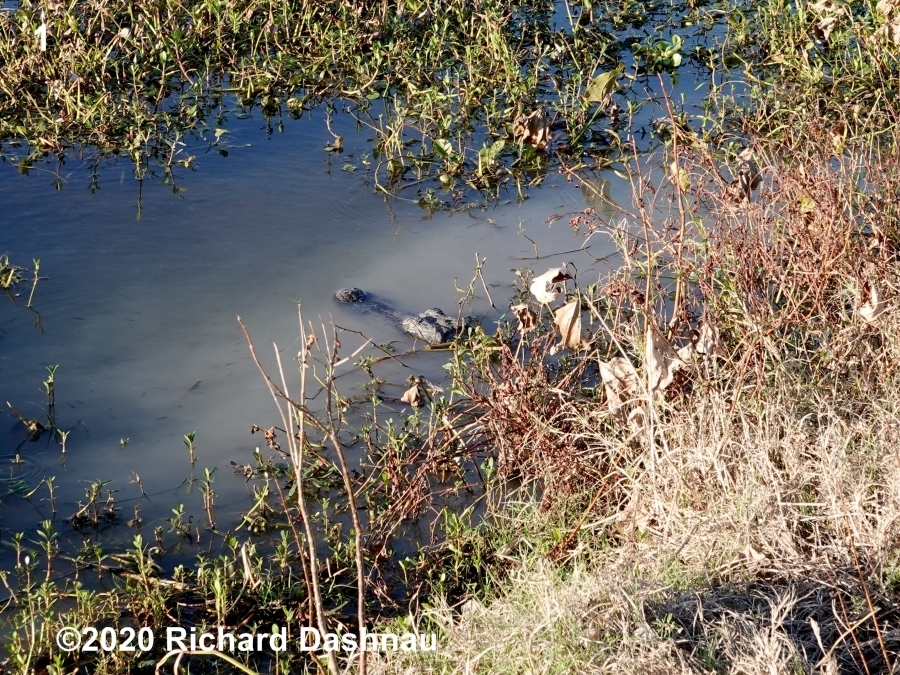
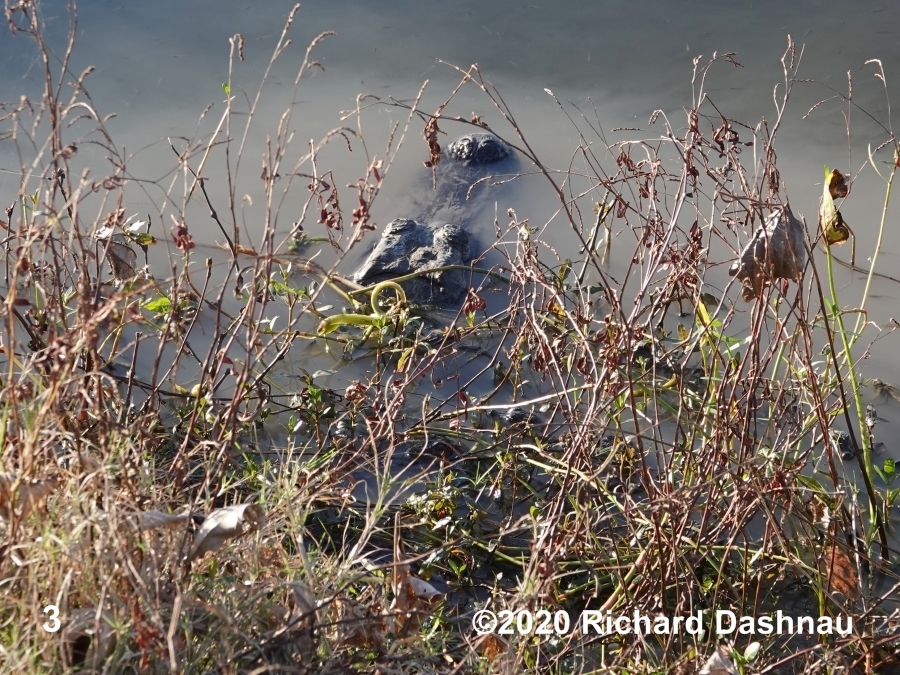
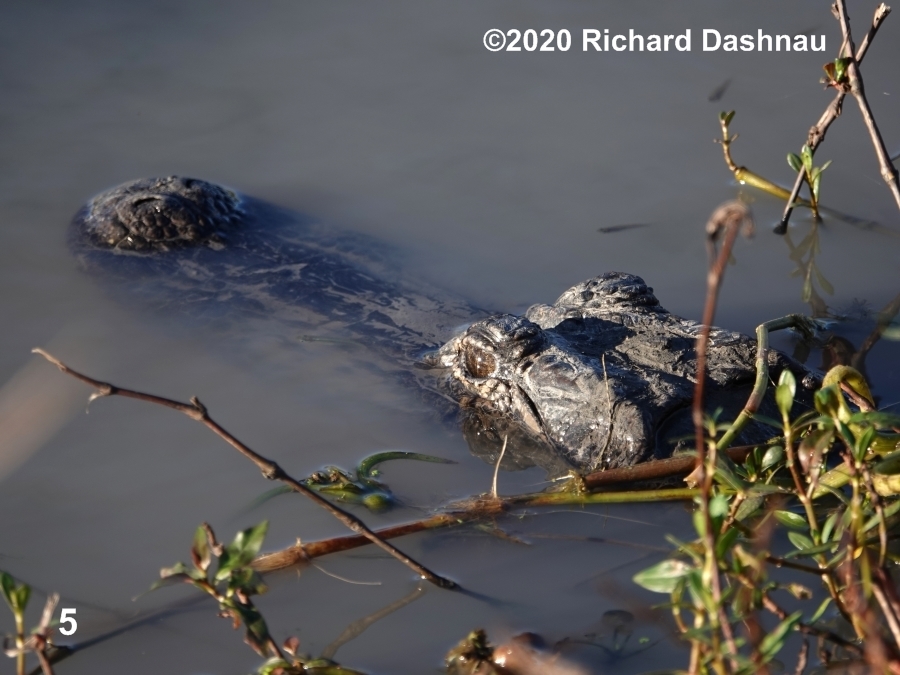
Mother alligator was
sometimes visible, with her head at
the surface as before; but then she'd submerge; and slide BACK INTO HER
BURROW. So, sometimes she was visible when visitors
came by, and
sometimes she wasn't.
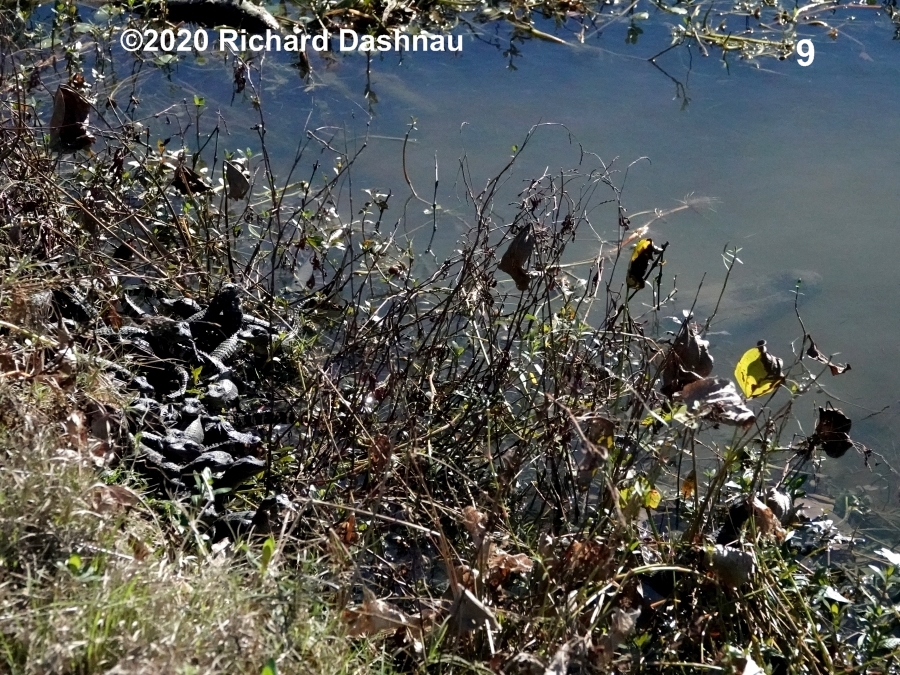
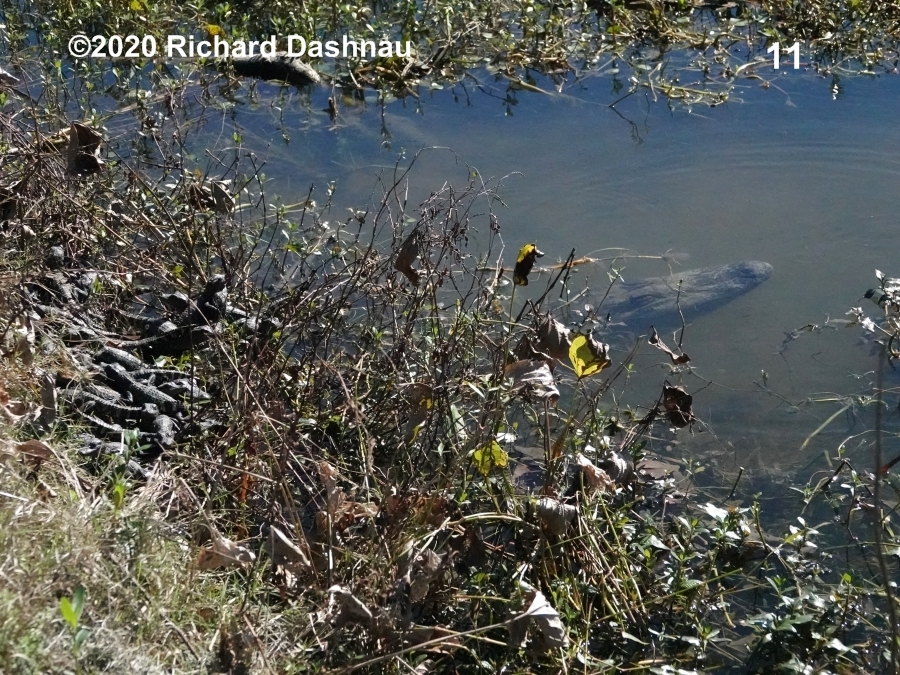
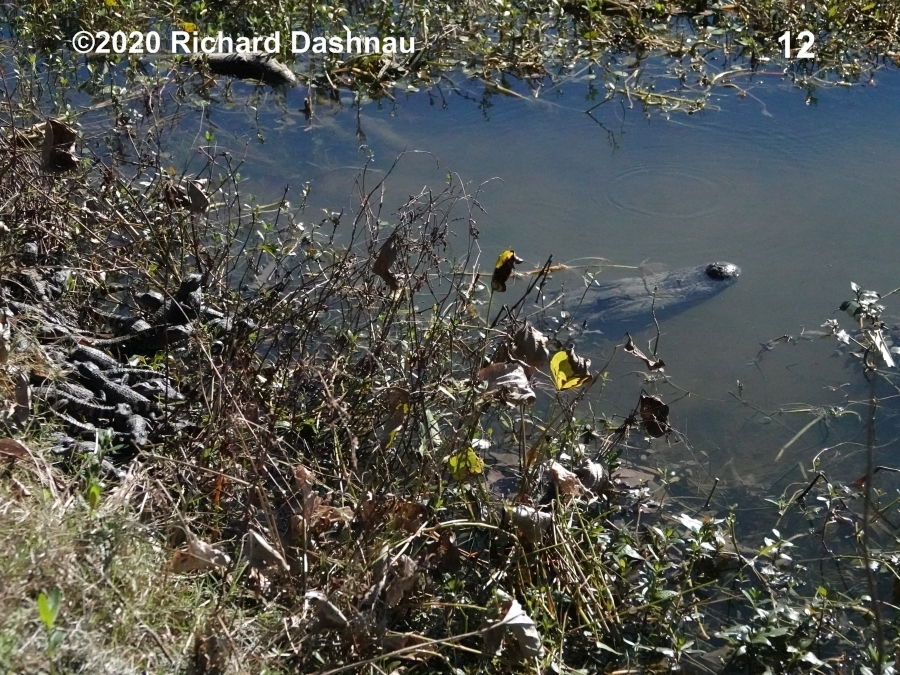
01/26/2020
I visited the baby gators and their mom a week
later.
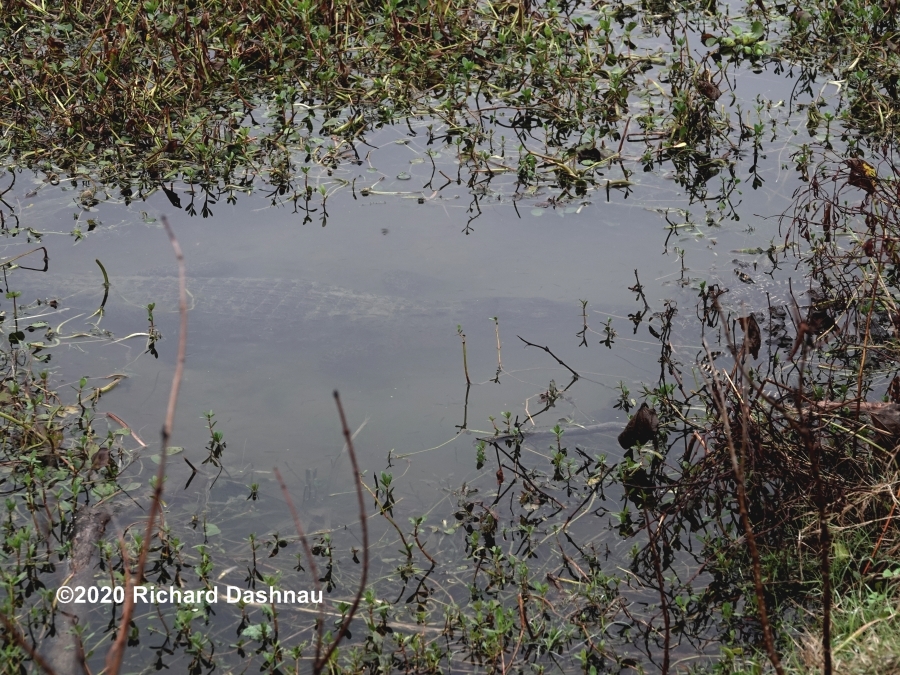
02/02/2020 Mom
gator
submerged at 10:30, then surfaced to breath at 10:50...about
20
minutes under water.
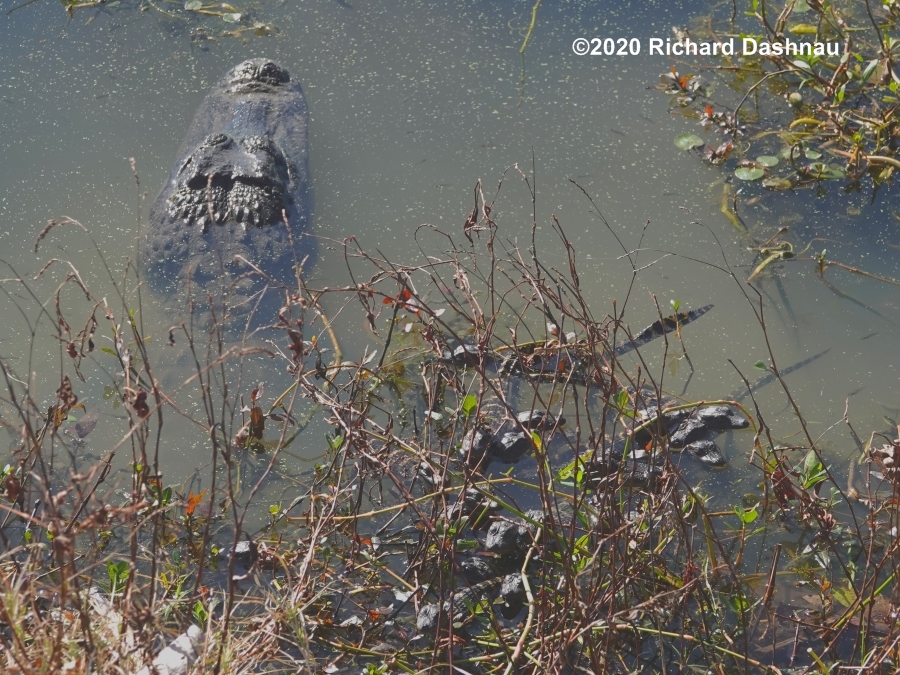
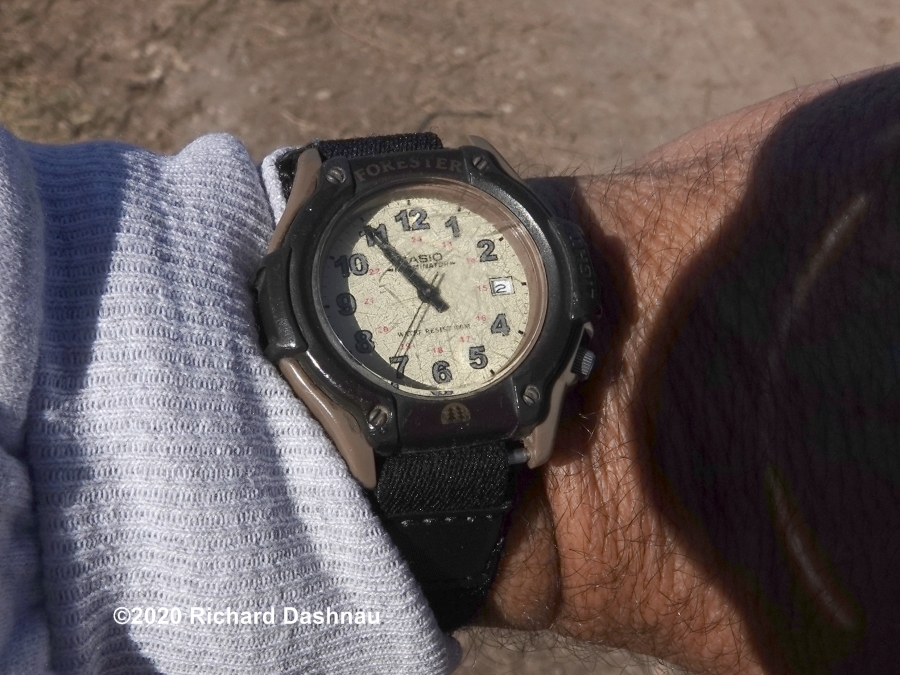
At
12:06,
Mother submerged and backed into her burrow until she was
hidden. She remained hidden until surfacing at 1:05---about 1
full hour
under water!
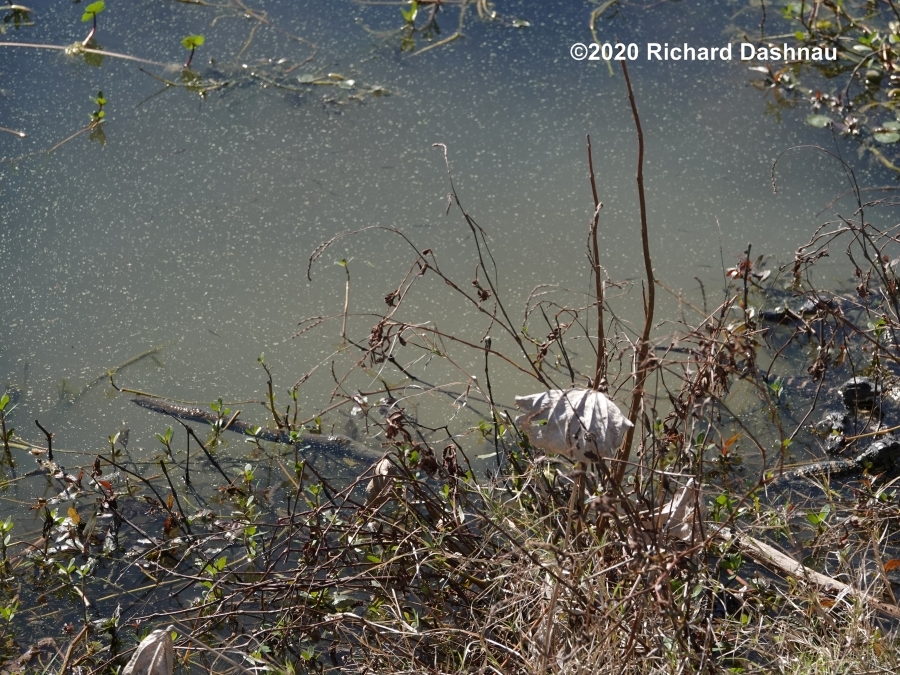
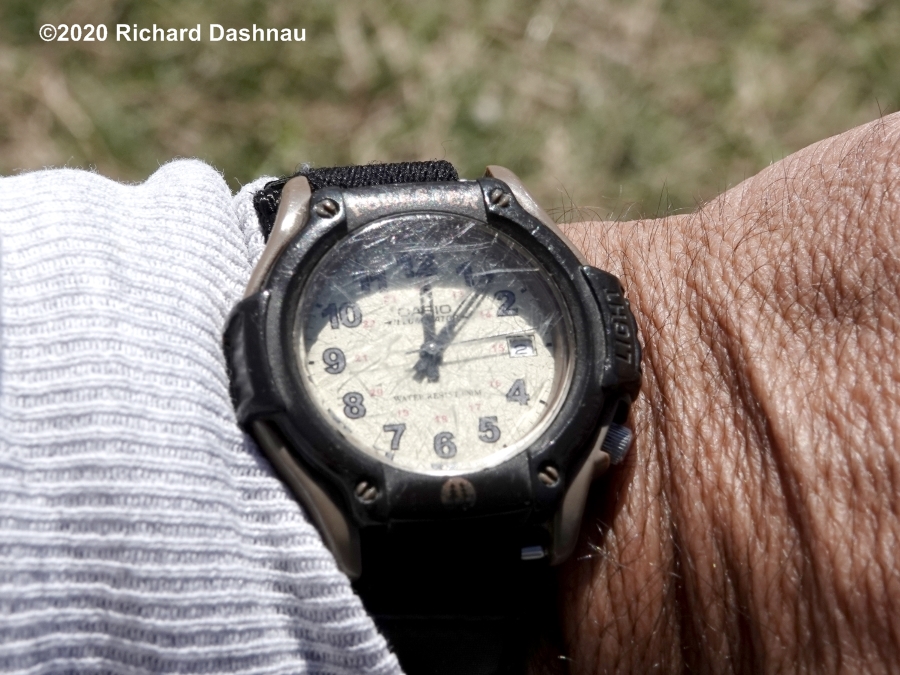
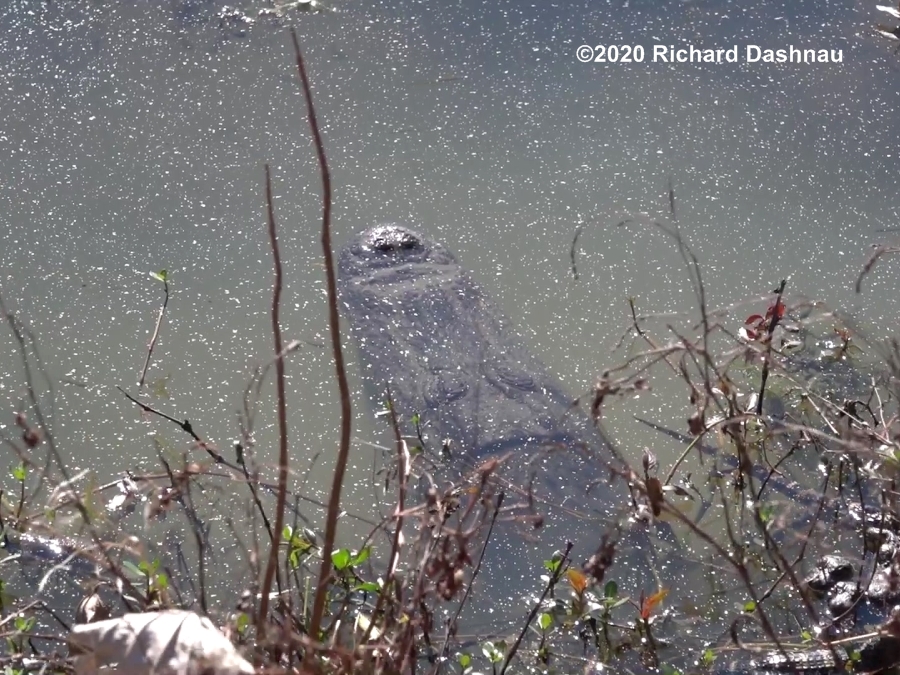
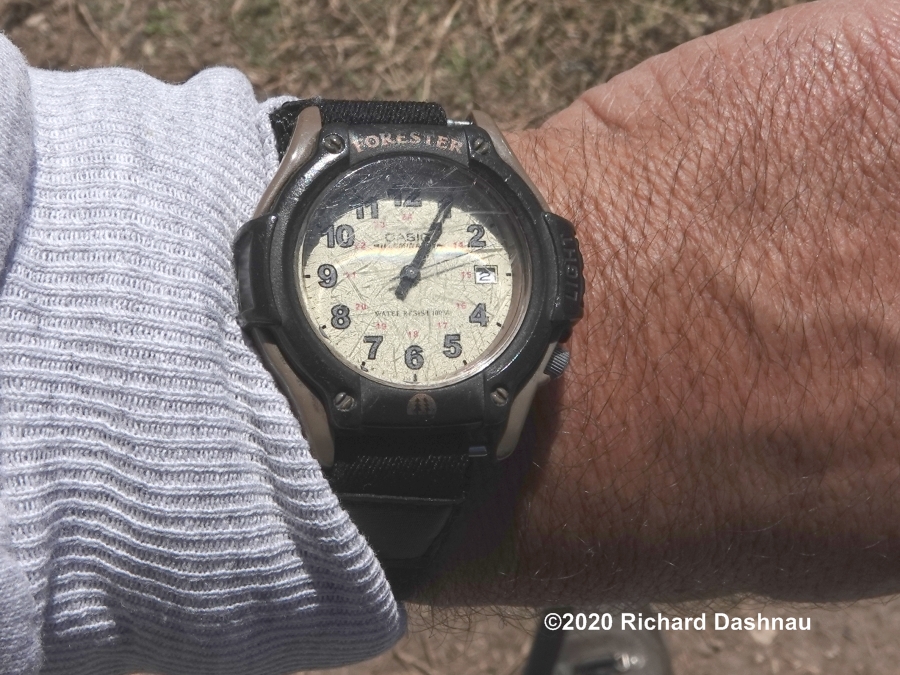
02/16/2020
At
10:57 she swam back to
the pod From 11:01 - 11:05 mom moved back near the
pod. She had been gone for 45 minutes!
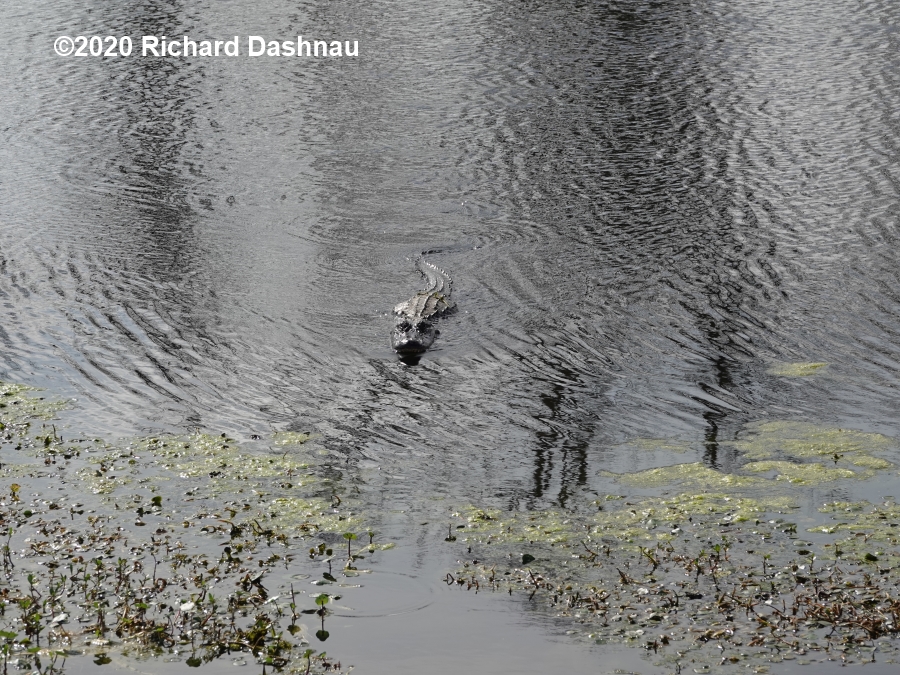
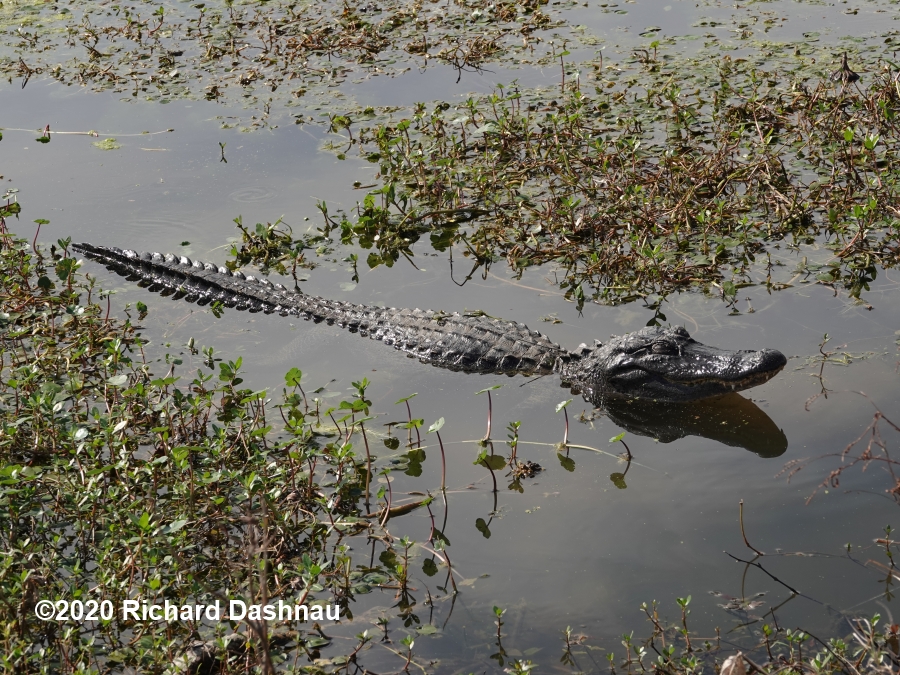
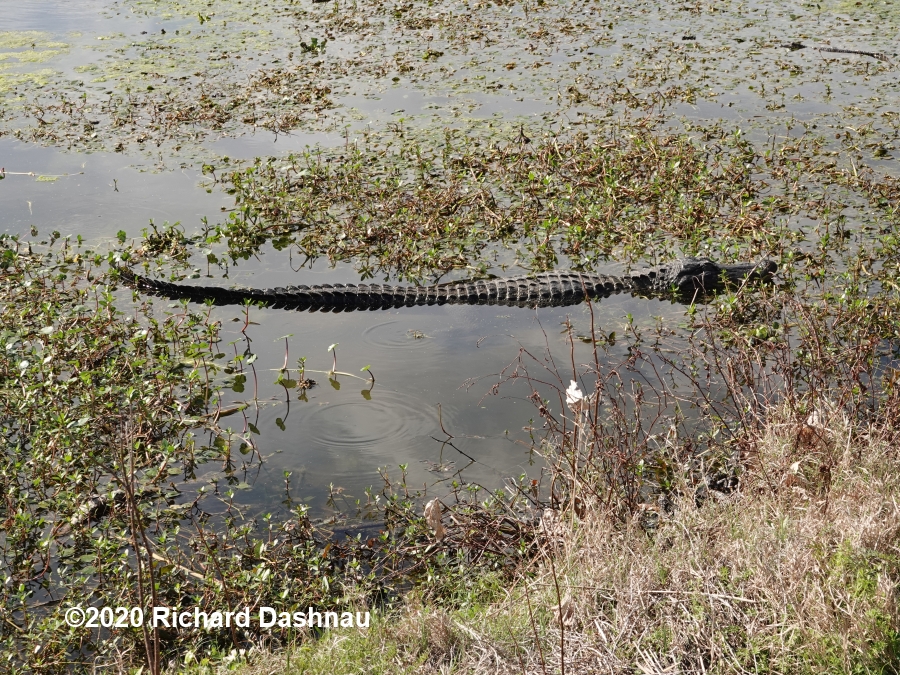
03/15/2020
This day was the last day for me to visit Brazos
Bend State Park for a while. With
the warnings
about the coming pandemic, and travel and social-
distancing protocols being
put into effect, I had decided not to go to the park.
Over
the weeks
that followed, protocols put into effect by the BBSP,
and
the state
took the decision out of my hands anyway. So...this
morning I was
walking with 2 new volunteer trainees. I intended to show them
the mom
gator and her babies, but
she wasn't there!
10/16/2022
This
summer, BBSP suffered from the same drought as the rest of
Texas. There
are other references to this on some of my other pages. The
last
rain
before this day was in mid August of this year, and there
hardly any
after that. Water in 40 Acre lake was at least 3 feet lower
than usual.
This den was
exposed, and is the same one in the images above and on the previous page. There are at least 2
reasons that the area looks different than in the pictures
above. 1) The exposed mud in the new pictures and 2) About
2 and 1/2 YEARS have passed since the older images.
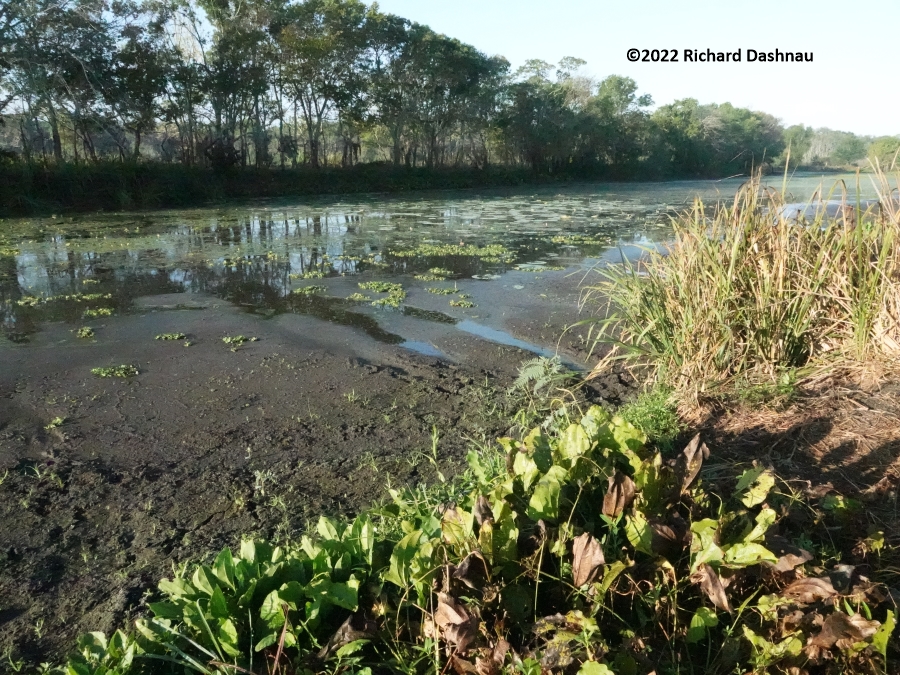
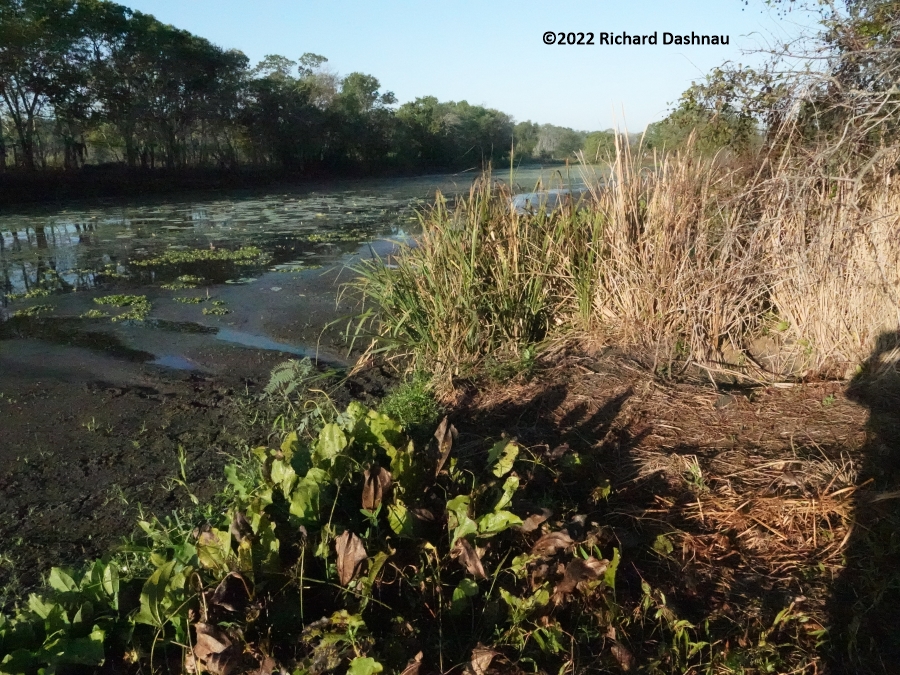
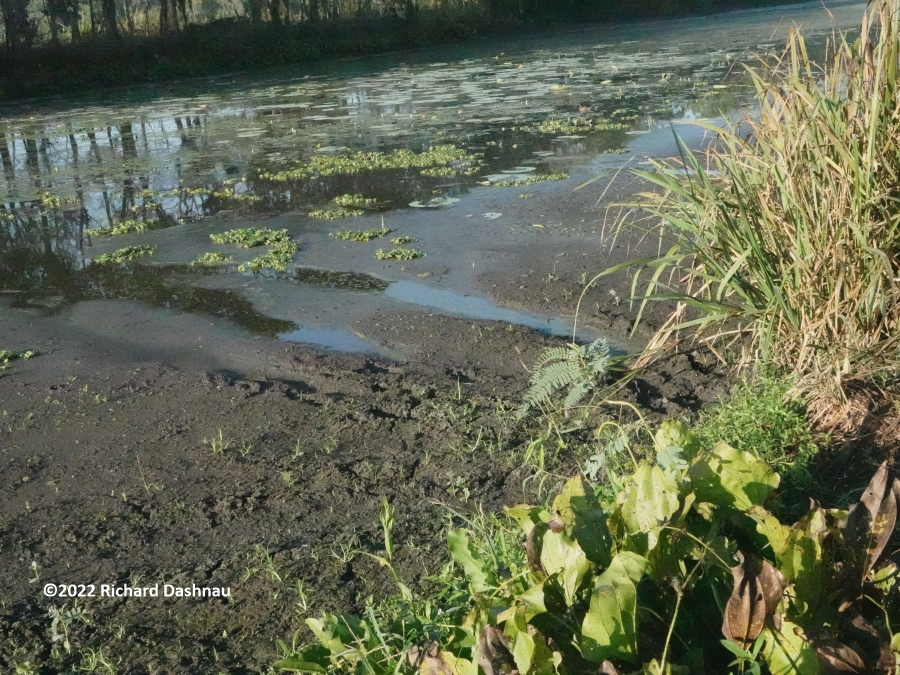
There
were two trenches, and multiple sets of footprints near, so I
didn't
approach too close to the den. The stick in the last image
below is 6
feet long. I moved slowly
and carefully, then left quickly
while intently watching the opening of the den. Although
I was
very quiet, I was aware that my shadow could move across
the
opening
and bother anything hiding inside.
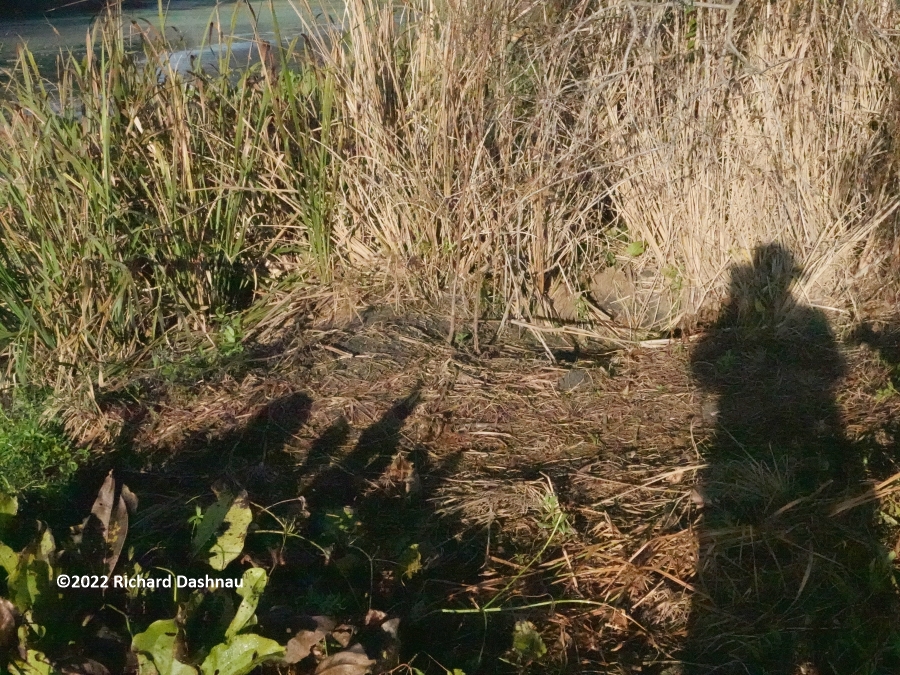
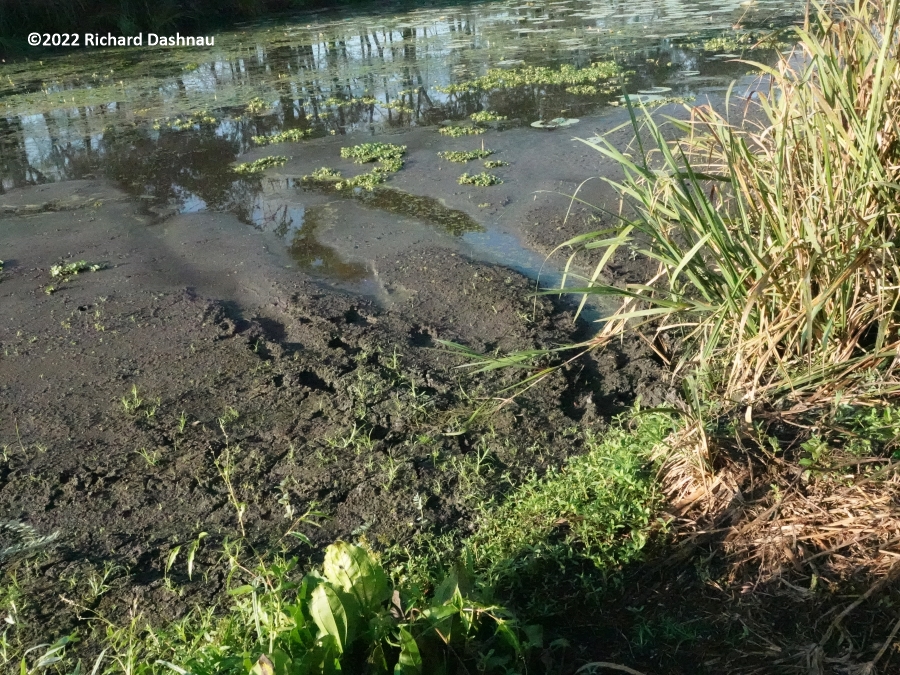
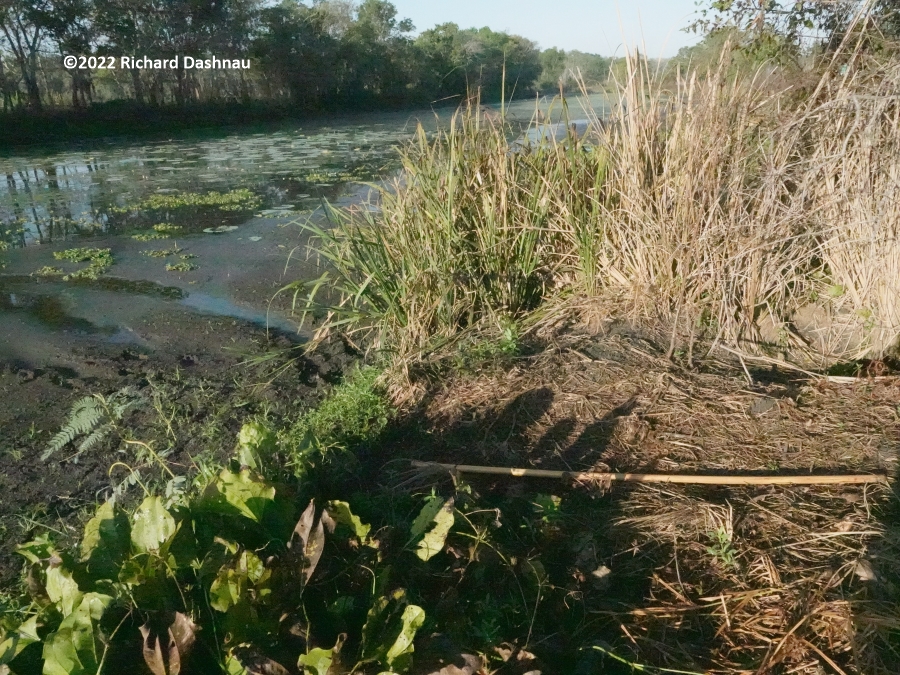
Two
stitched panoramas below may help give some scale. This was
the first
day that I photographed the den, but I monitored it more after
this.
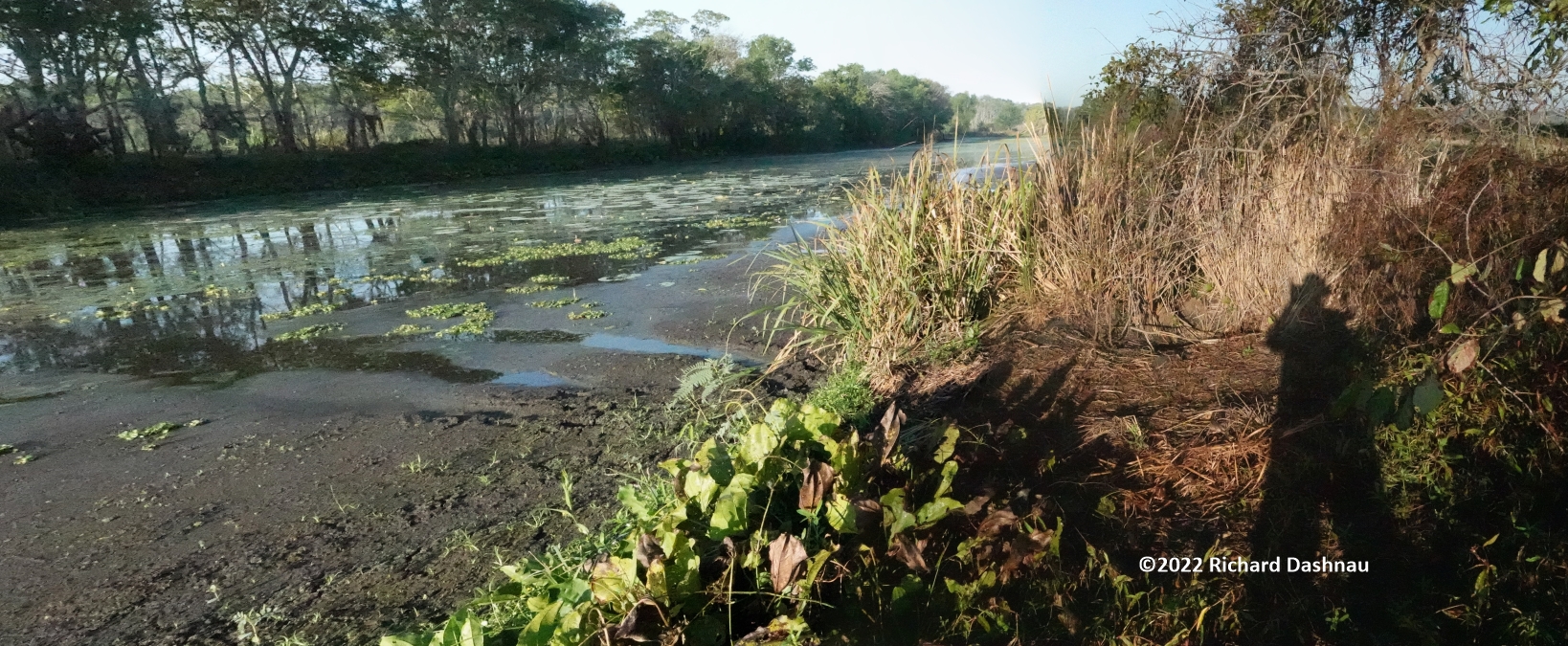
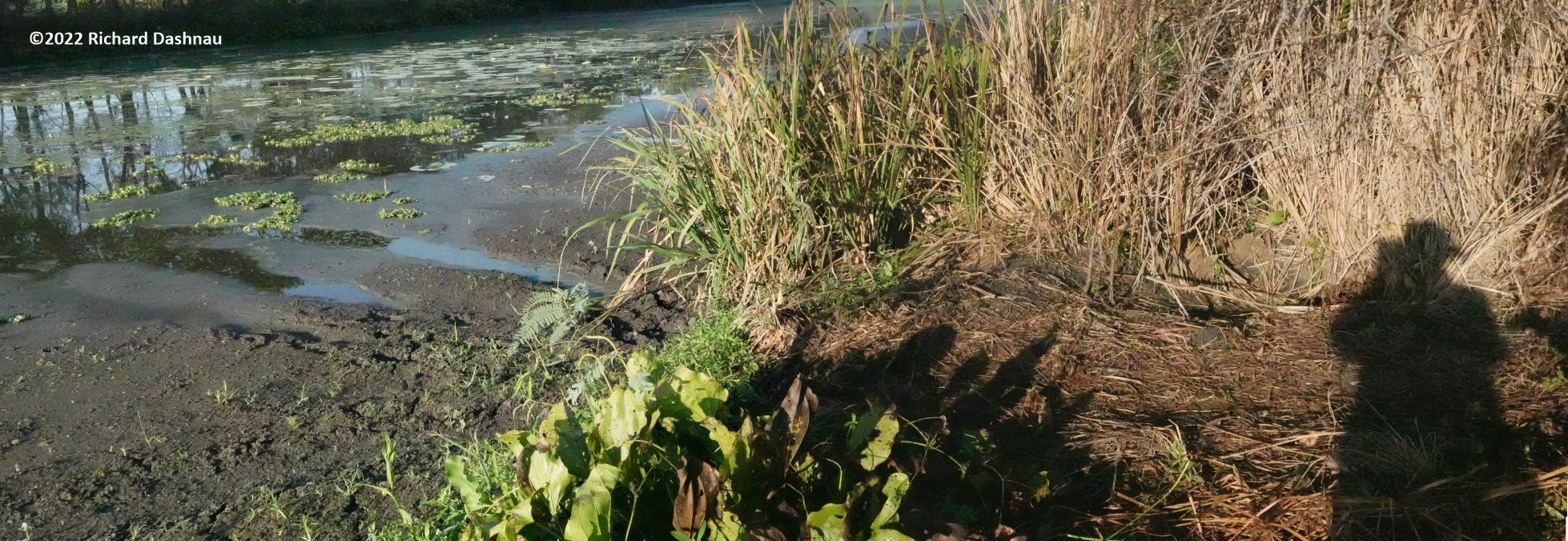
12/25/2022
This
was the last set of images of this den from 2022. They don't
show much,
but this was December, after all. Since I'm usually in
this area
about
8am, and I'm facing West for the picture, my shadow is
long and dark; and if I'm not careful, it can fall across the
den.
Temperature when I got of out my car
was 37°F (15 minutes
earlier), so I didn't expect to see the alligator (if it
was in
the den); but hoped to see its nose exposed for breathing. But
it would
hide if my
shadow crossed the the den. No luck this morning. But...more
to come in 2023!
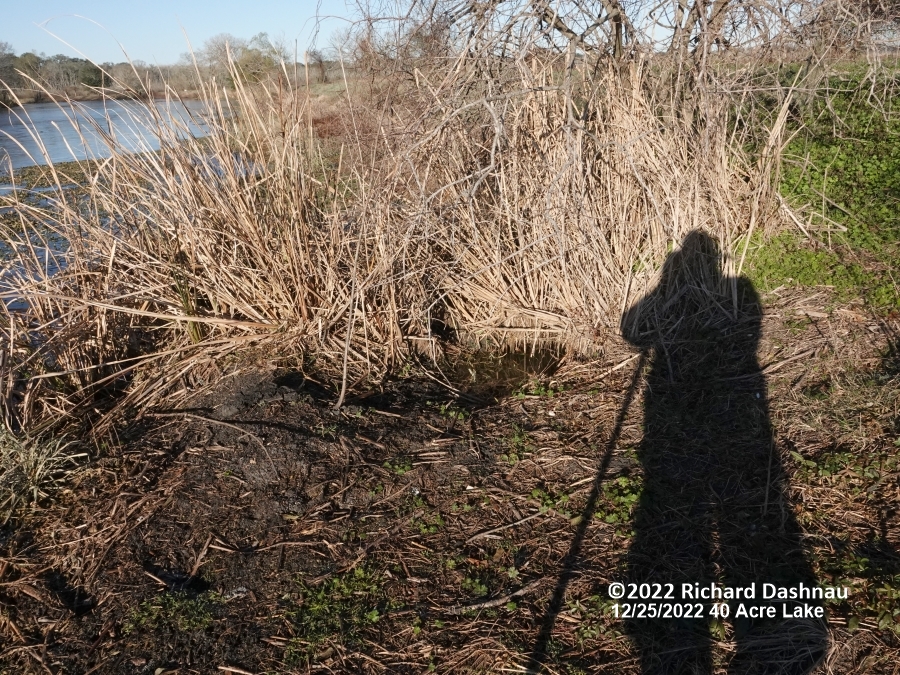
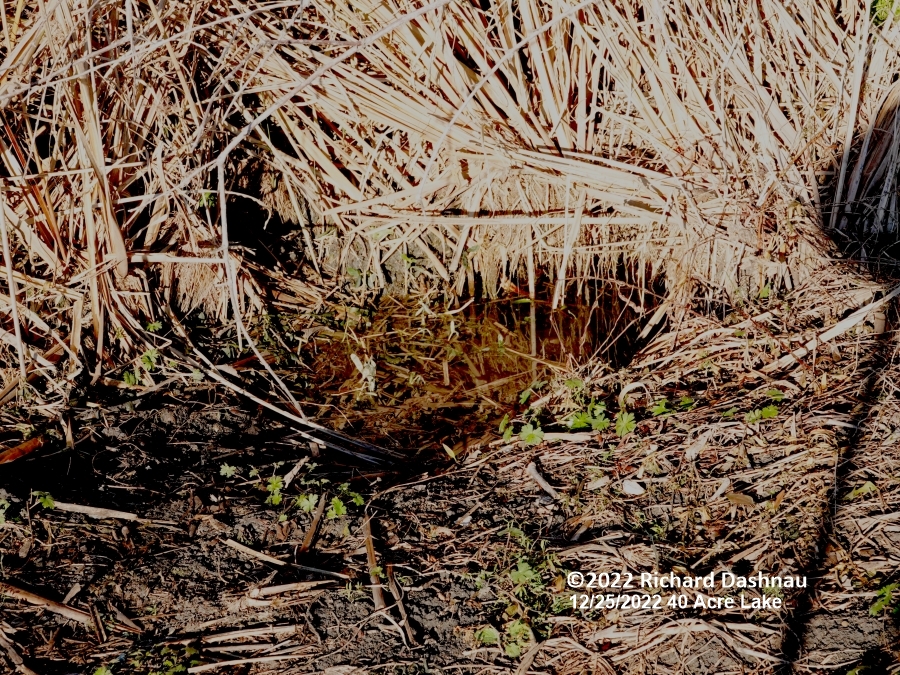
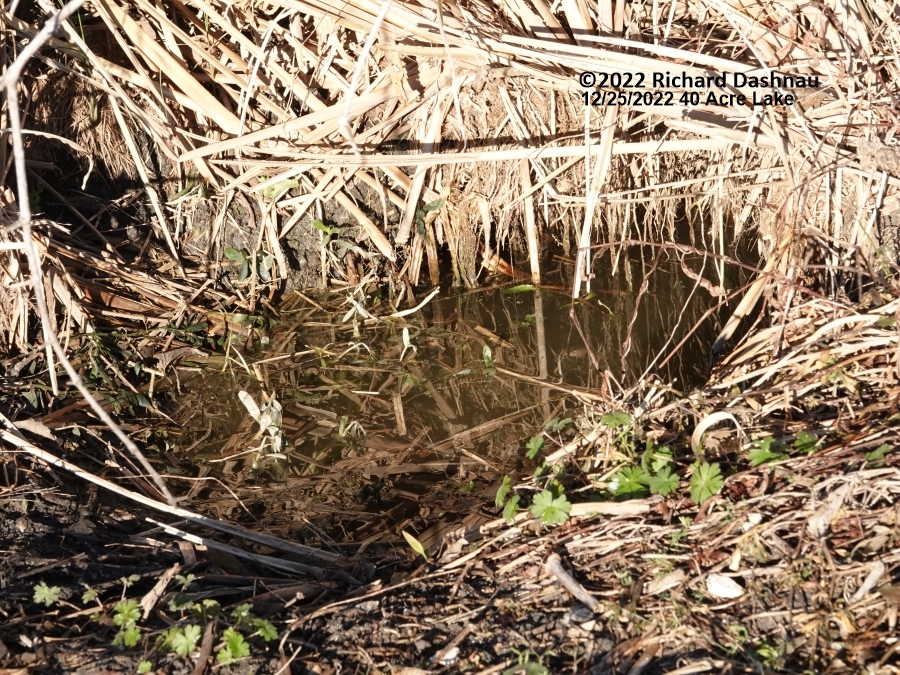
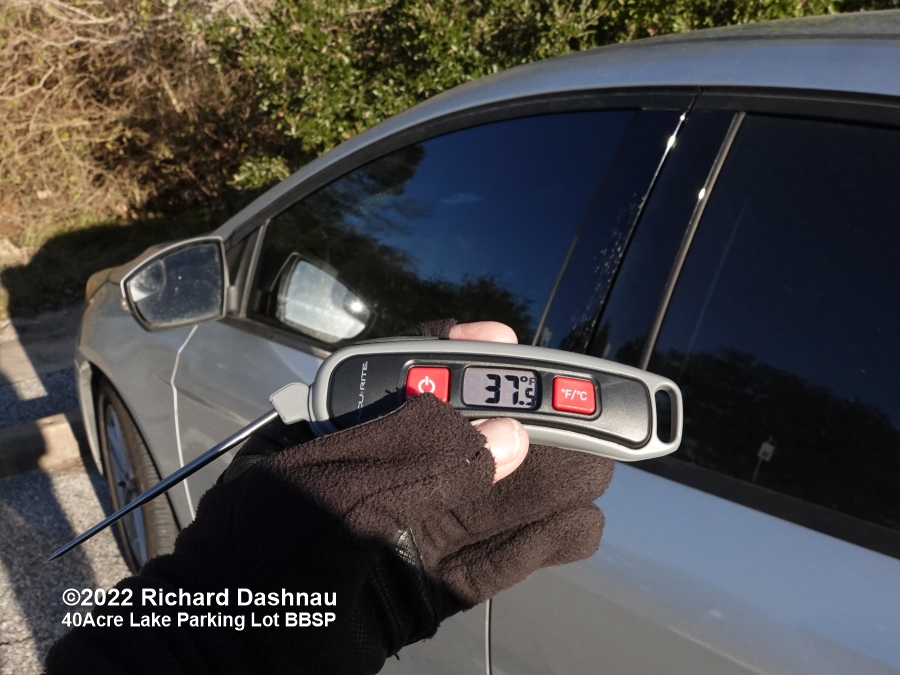
The
images
above don't give a full picture of conditions at Brazos Bend
on
that day. It will take me a while to format everything that I
observed
and captured that
day and I hope show some of that somewhere on one
of my pages (this is a reminder for me). But the images below
will give
some idea. All of them were taken
close to 8:30am that day.
Note that the water in the den opening was...water. But all
around it,
the water was frozen. The first two images below show the rest
of
40Acre
lake. The third image shows the West end of Pilant Lake, on
the North
Side of the trail (40Acre Lake is South of the trail at this
point.)
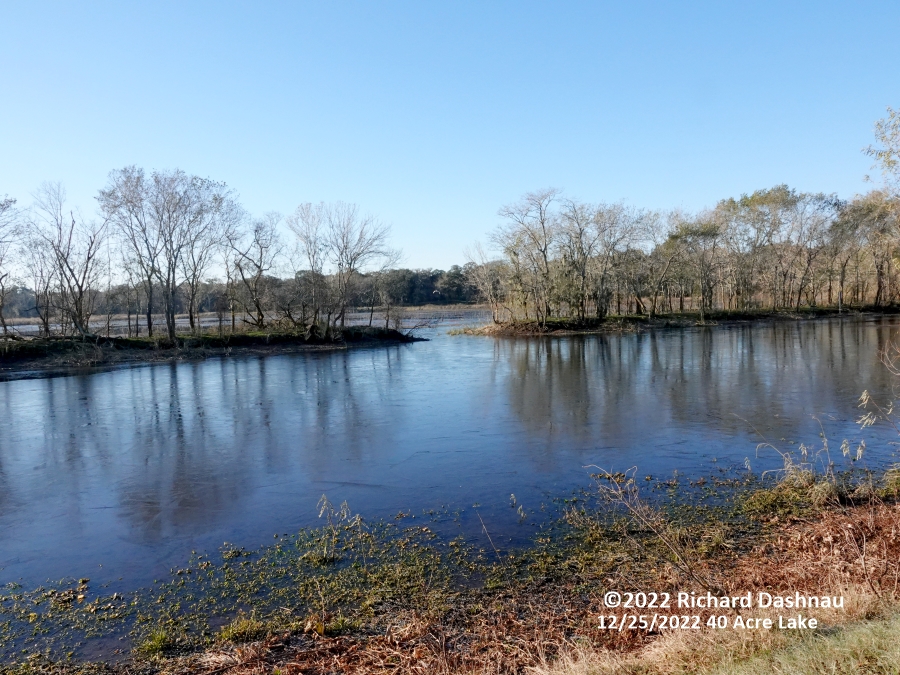
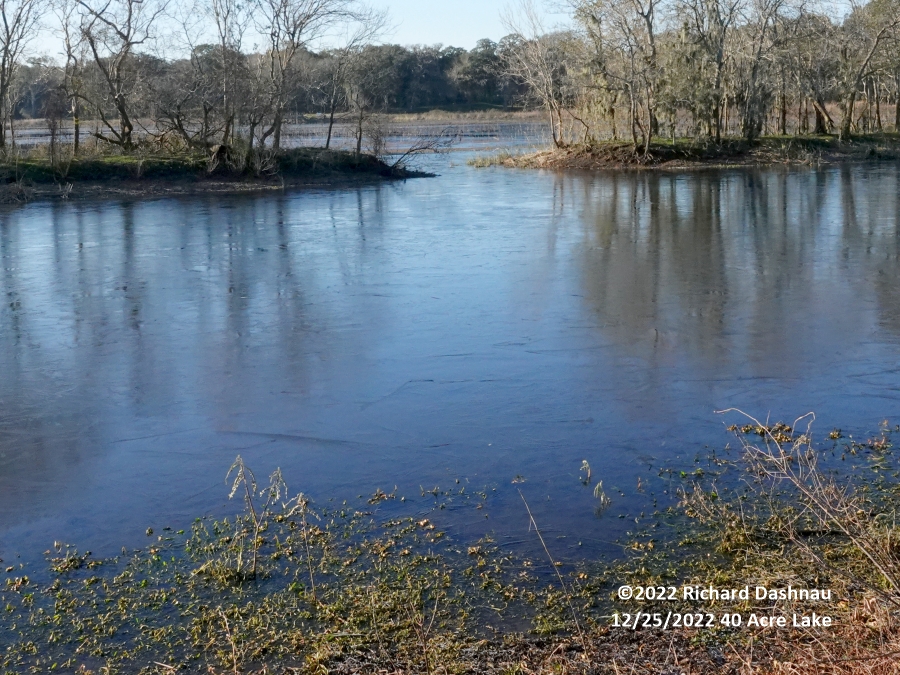
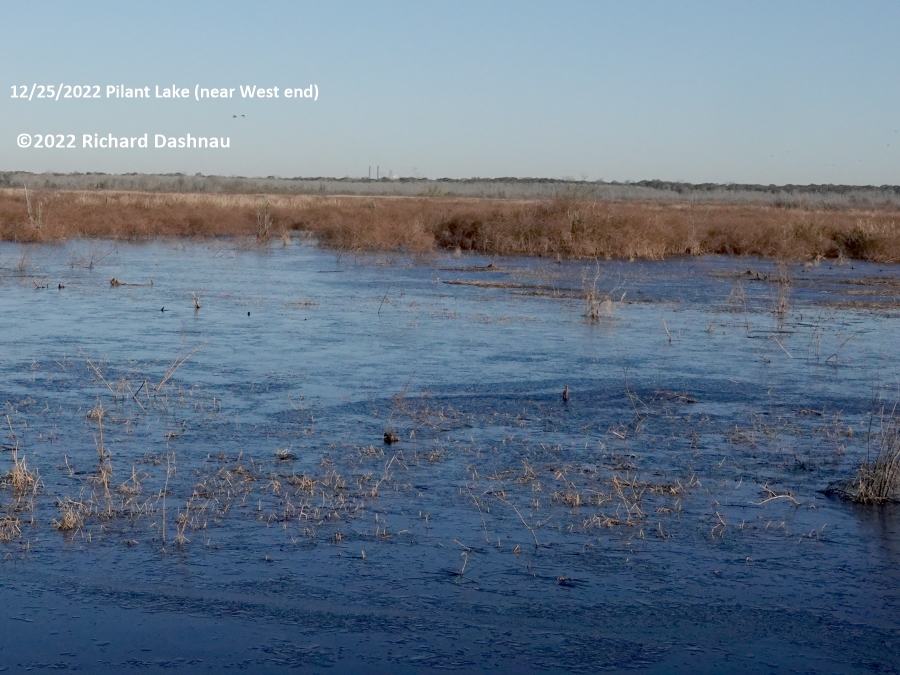
This
shows a wide view of that entire area with the surface all frozen!

Closer
to the Observation Tower (East of above), ice covered almost
all of
Pilant Lake. But I noticed something at the far edge of the
water--about 800 yards away.
I needed optical magnification to see
what was going on, and the images below show what I saw. The
fourth
image shows ducks standing on the ice.
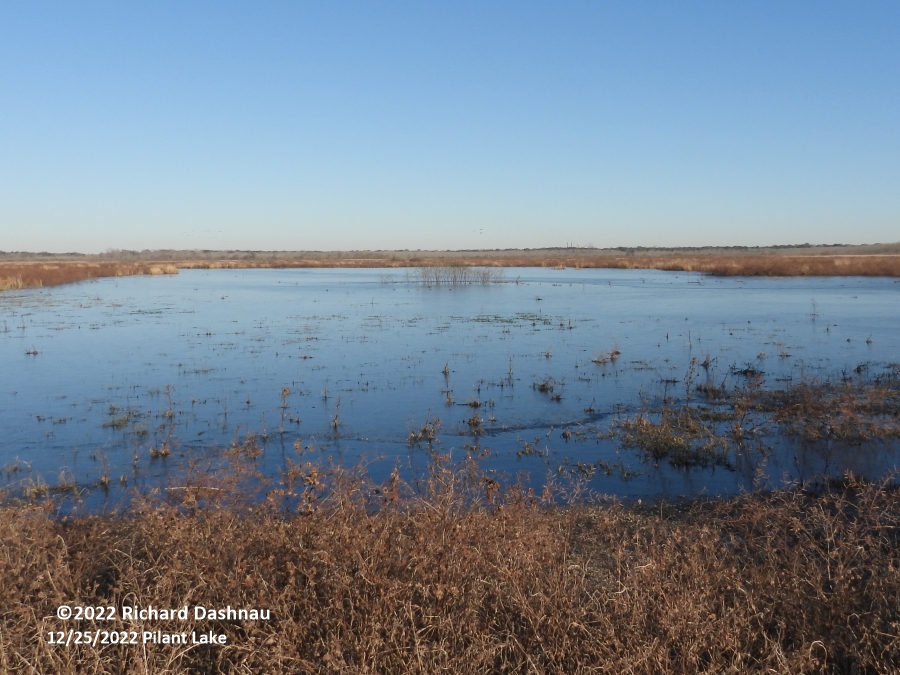
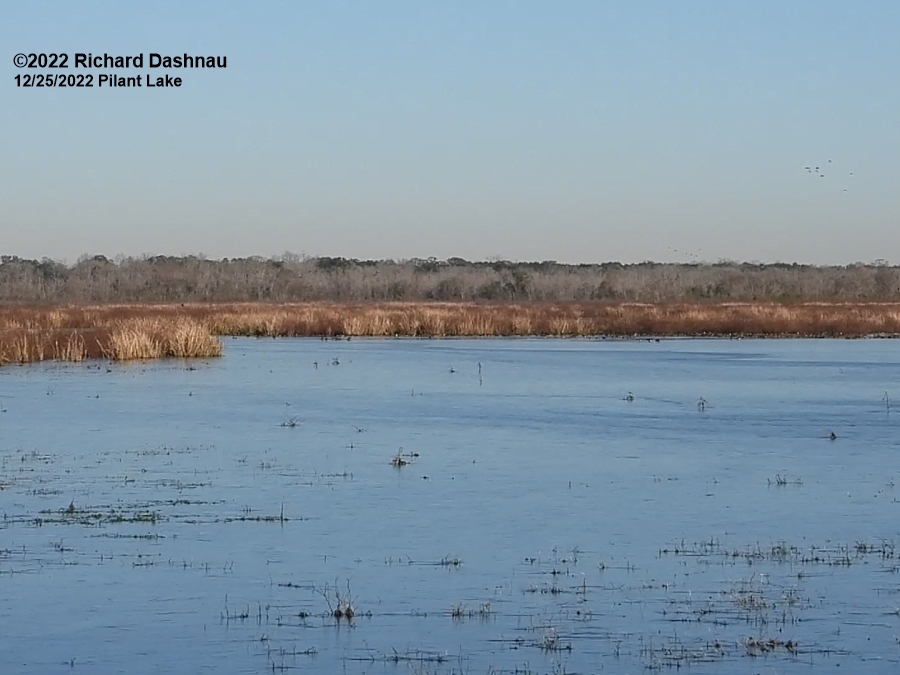
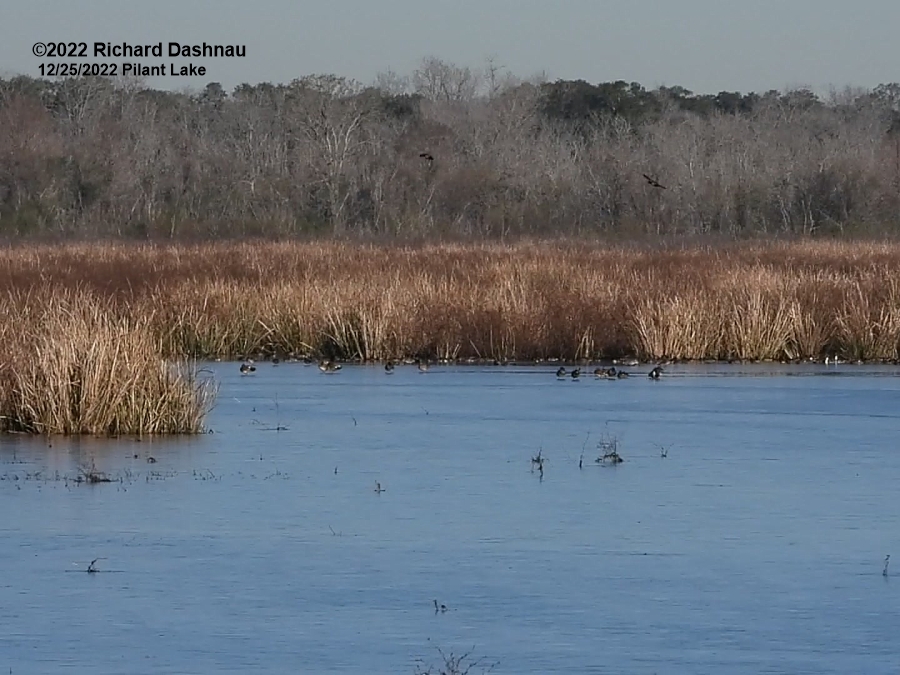
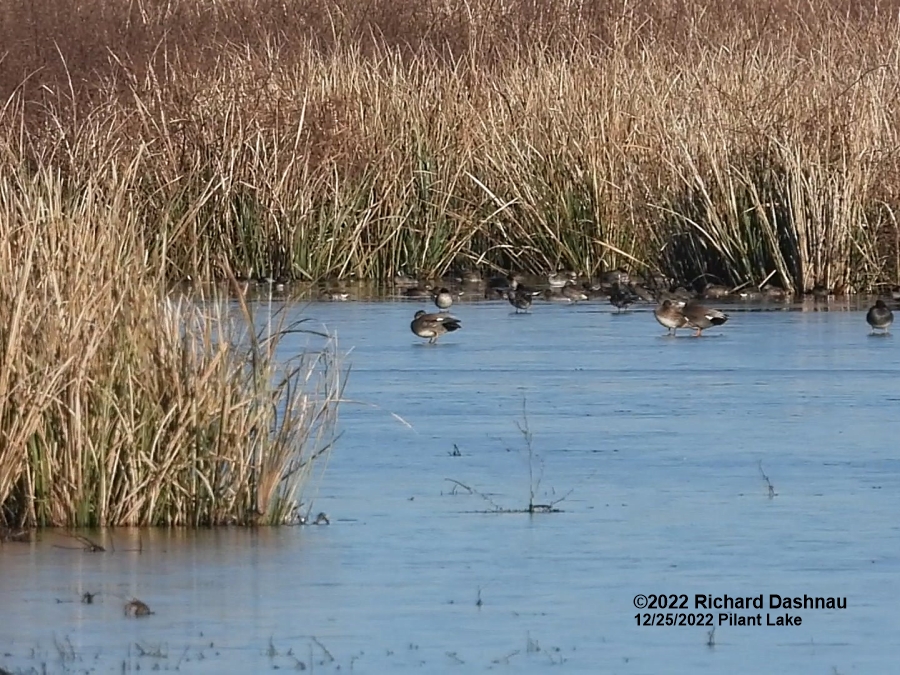
A huge
group
of birds was floating in the remaining unfrozen edge of the
lake.
If this seems odd (considering the cold), then remember
that the
ice is at or below
freezing (37°F, 0°C),
but
the water is warmer than that. I wonder if that crowd of
birds
soaking their feet and legs in the water also had any effect
on the
water and
helped keep it above freezing. Whatever the reason, the
birds were there. So, with ice all around, the water in the
den
remained liquid. This could be because the
den was excavated into a
bank that had good exposure to the sun. The den entrance-and
the
bank-gets direct sunlight. Direct radiation can heat the
den, while it
can also be warmed by residual heat from the
warmed dirt in the bank. There was a lot more to see
that day
(another reminder for me to put it together).
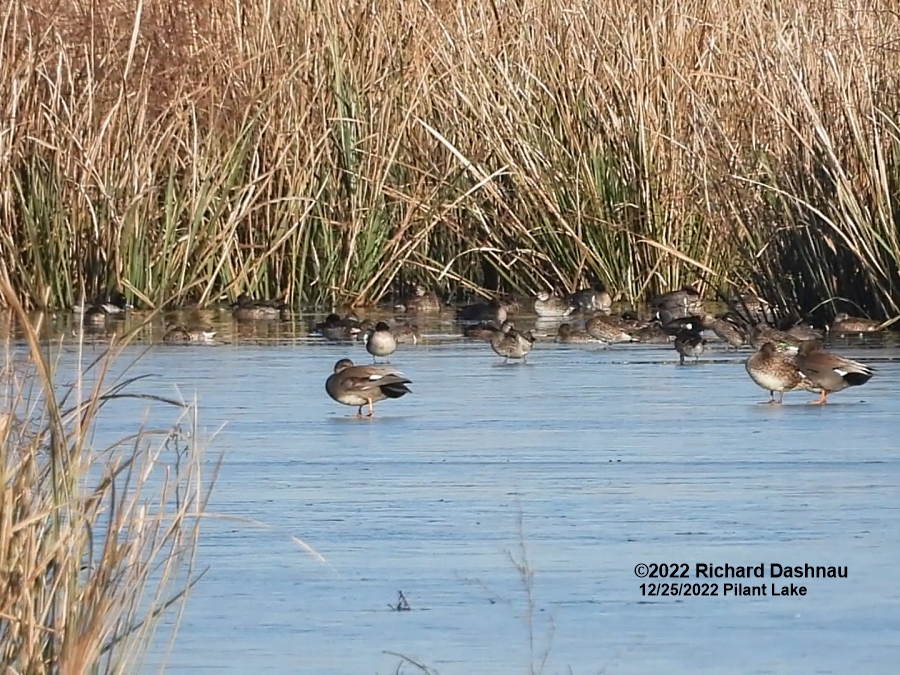
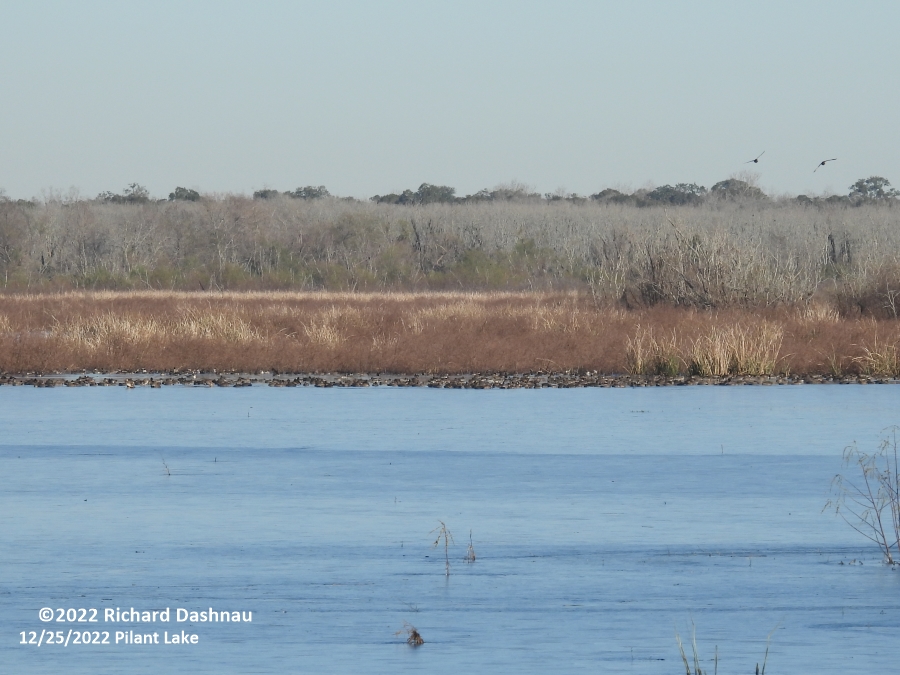
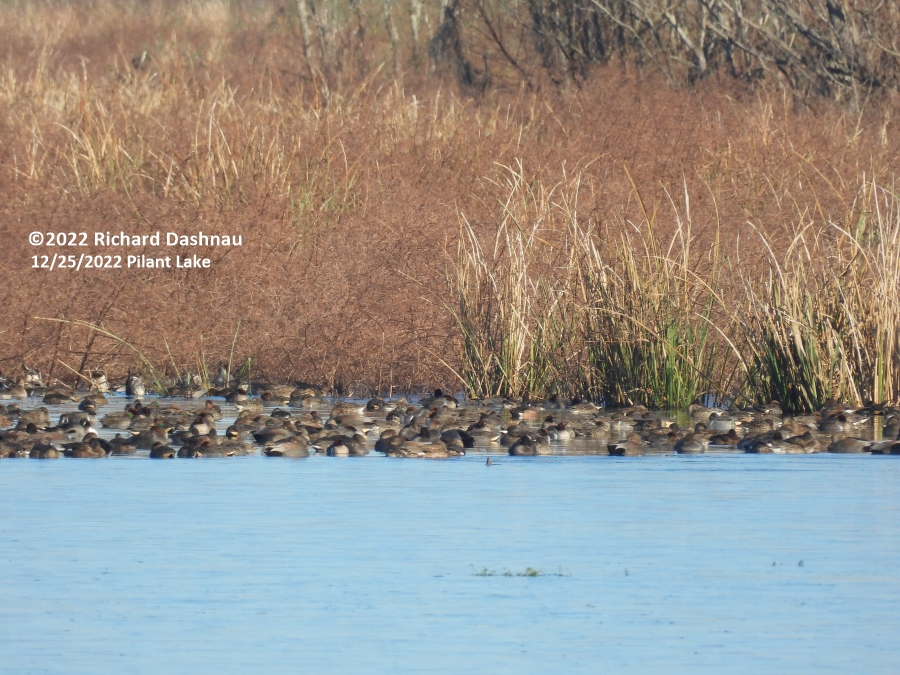
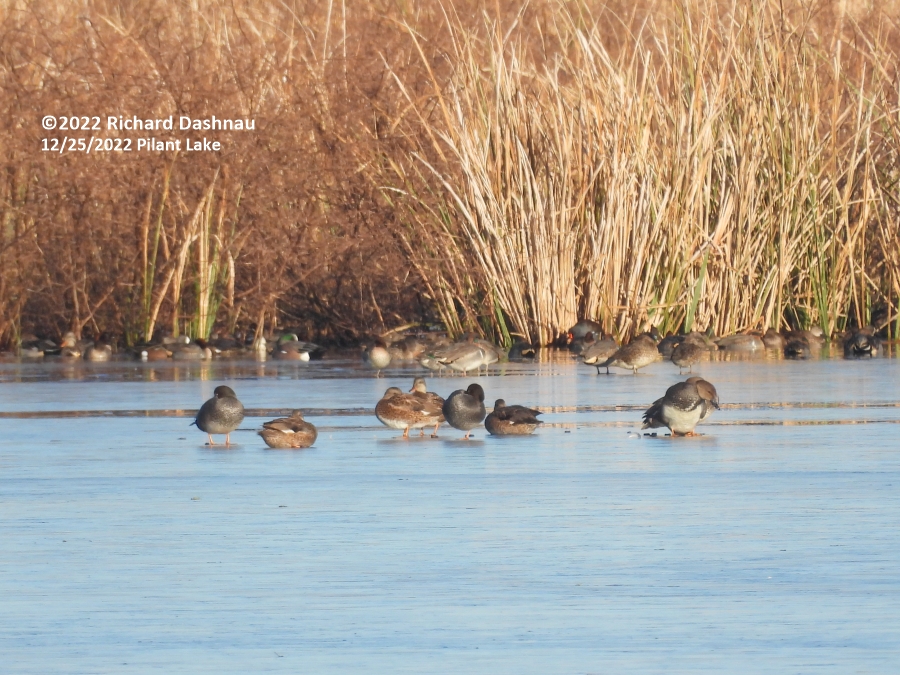


01/01/2023
When
I checked on the den today, I found signs that it was still
being used. The most obvious one was that large groove
in the
mud. That was
probably a tail drag mark (possibly multiple drags going
over the same spot?) made as the alligator moved in and out of
the den.
Multiple images to show from
different perspectives. Since the
den seemed to be inhabited, I didn't get very close. This was
mostly so
I wouldn't bother the alligator enough to make it feel
threatened and then leave the den as an unsafe area. I
wanted it to stay.
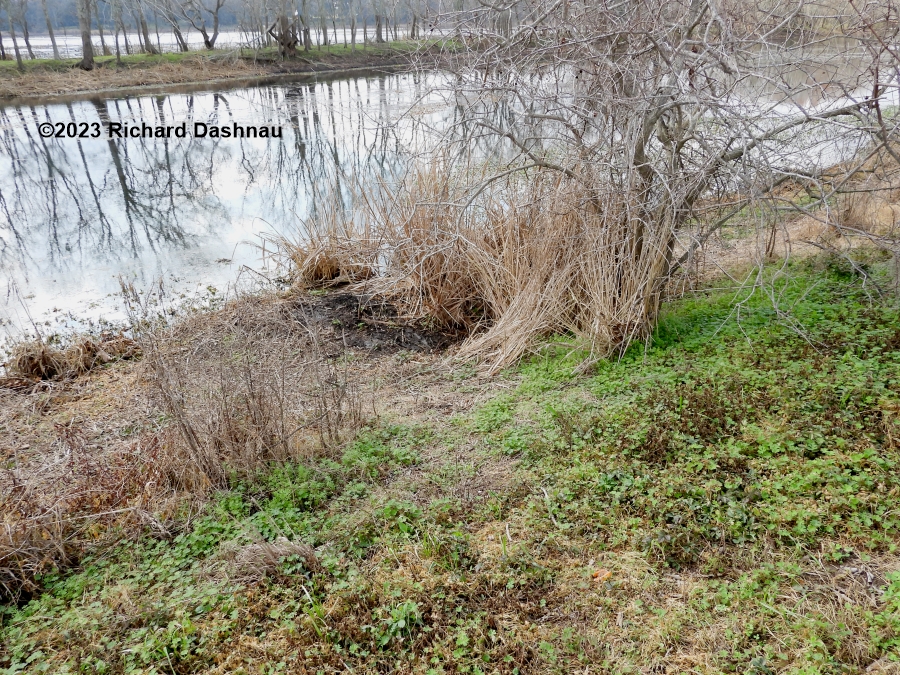
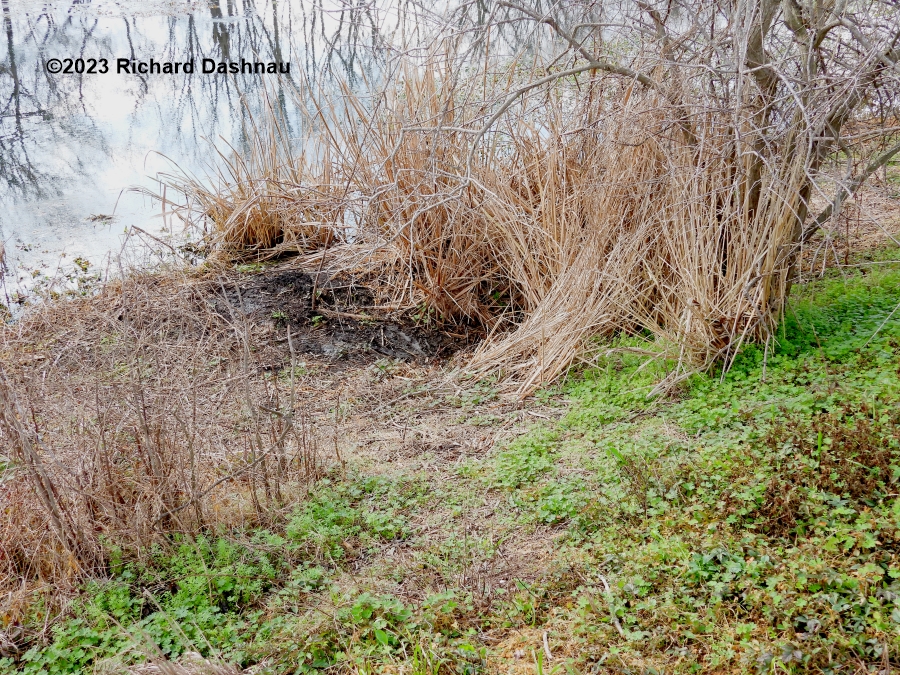
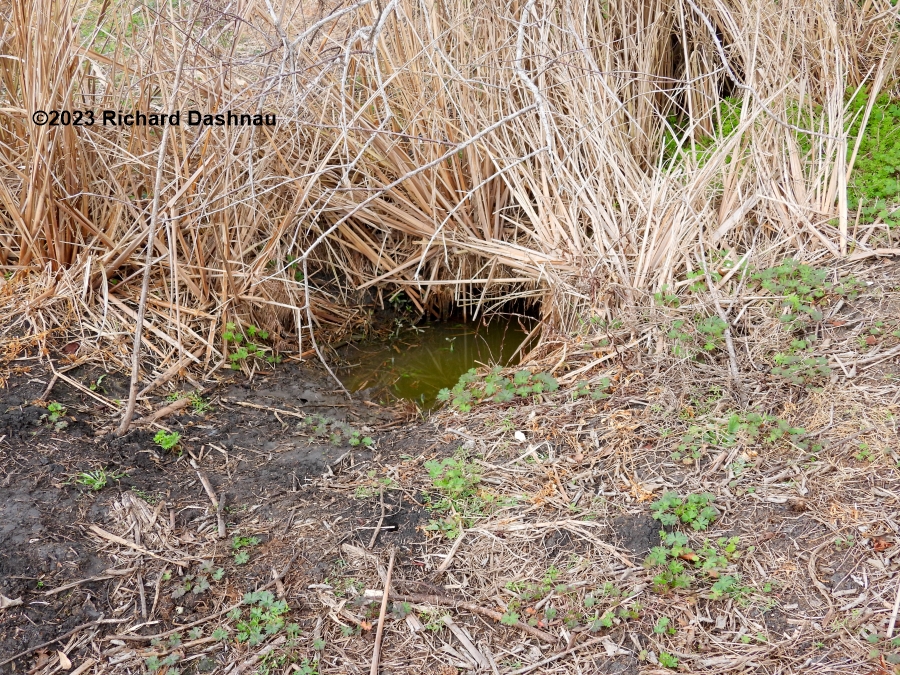
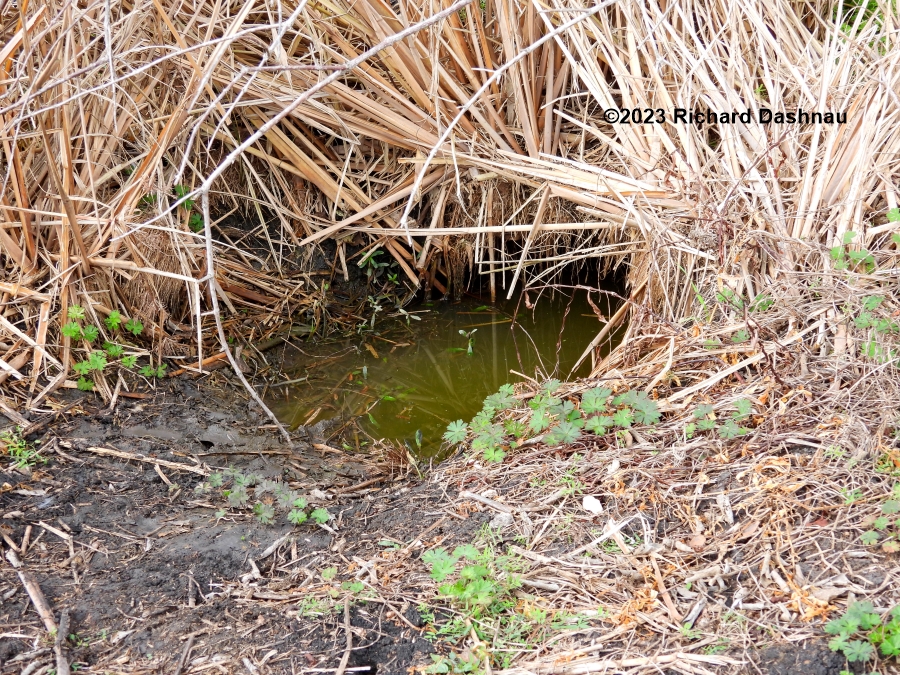
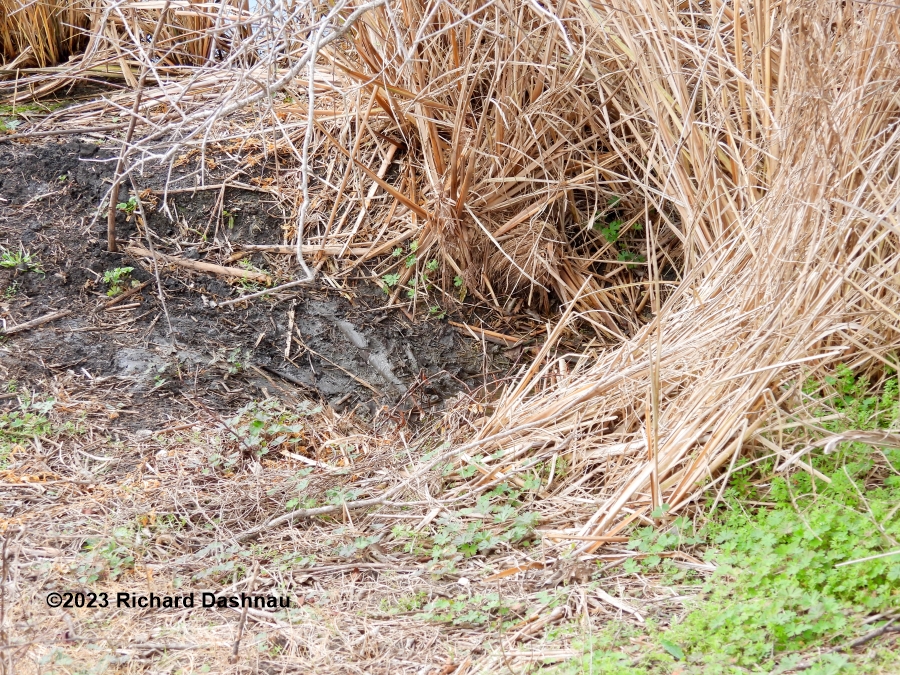
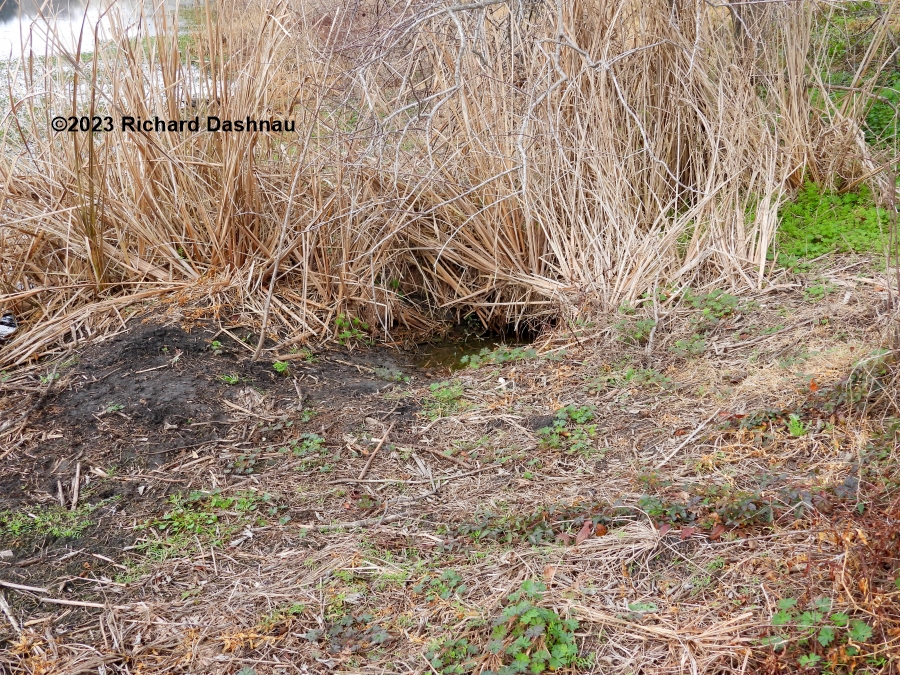
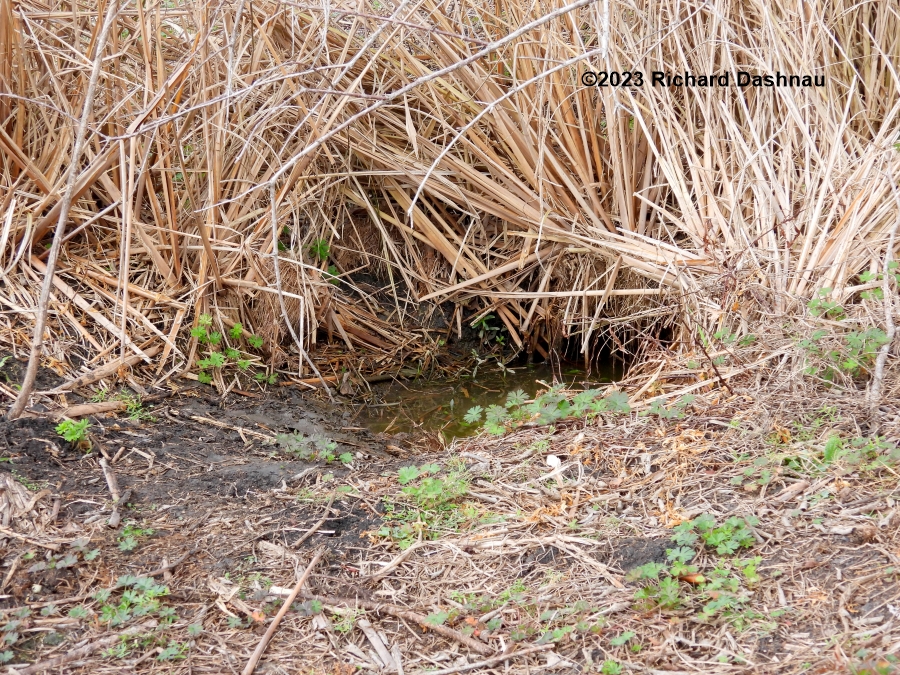
01/08/2023
When
I checked on the den today, I was happy to see signs that it
was still
being used. The mud in front showed smooth spots from
alligators sliding over
or
lying on it. If it hadn't been used for a while, the den
entrance and
the mound (formed from the mud removed from the den) would be
as dry
and overgrown as
the surrounding area. Also, note that this was all
under water when the den was constructed (see above).
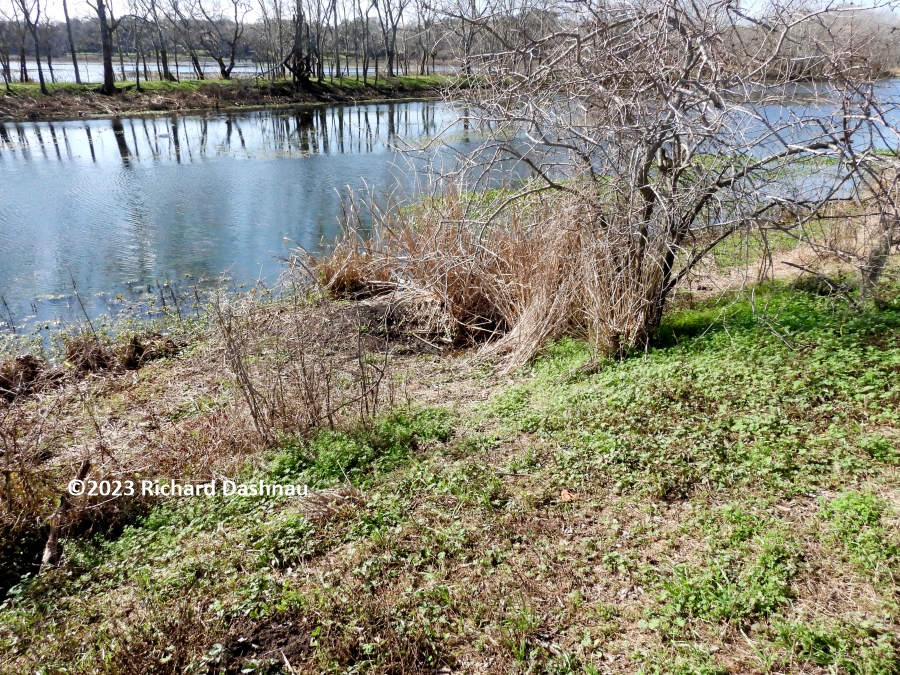
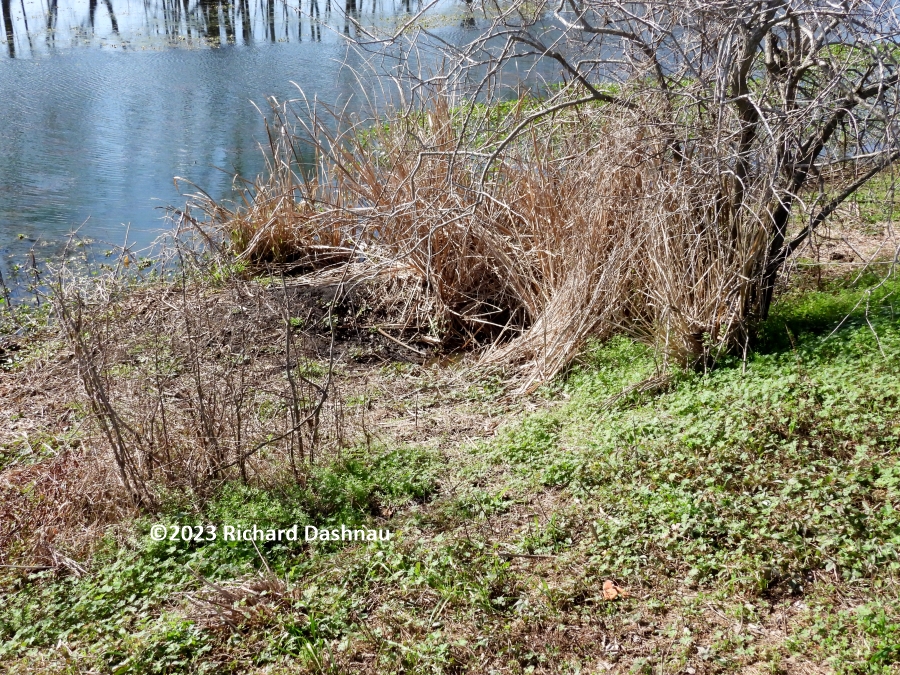
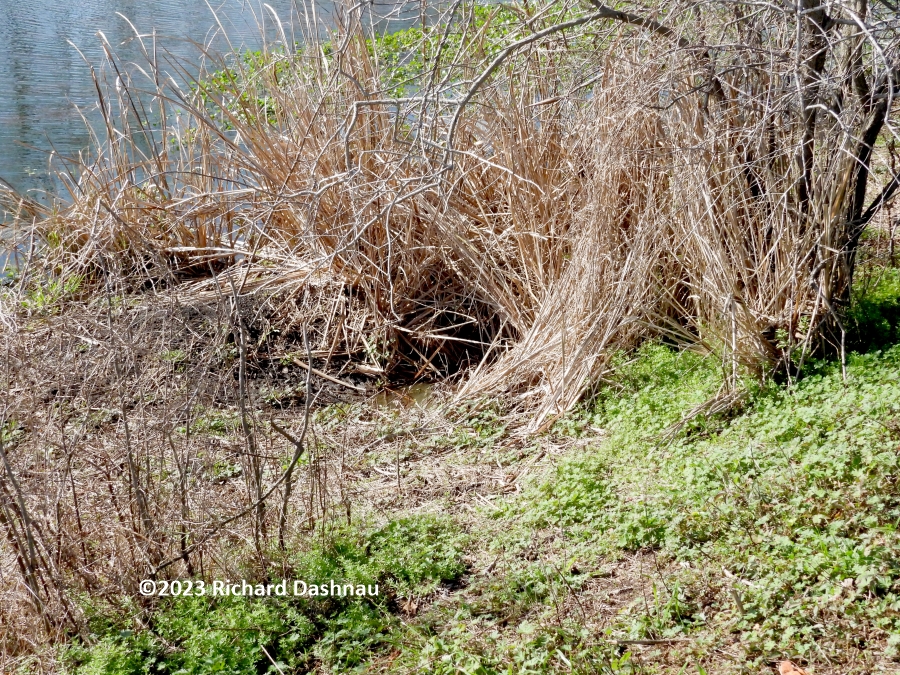
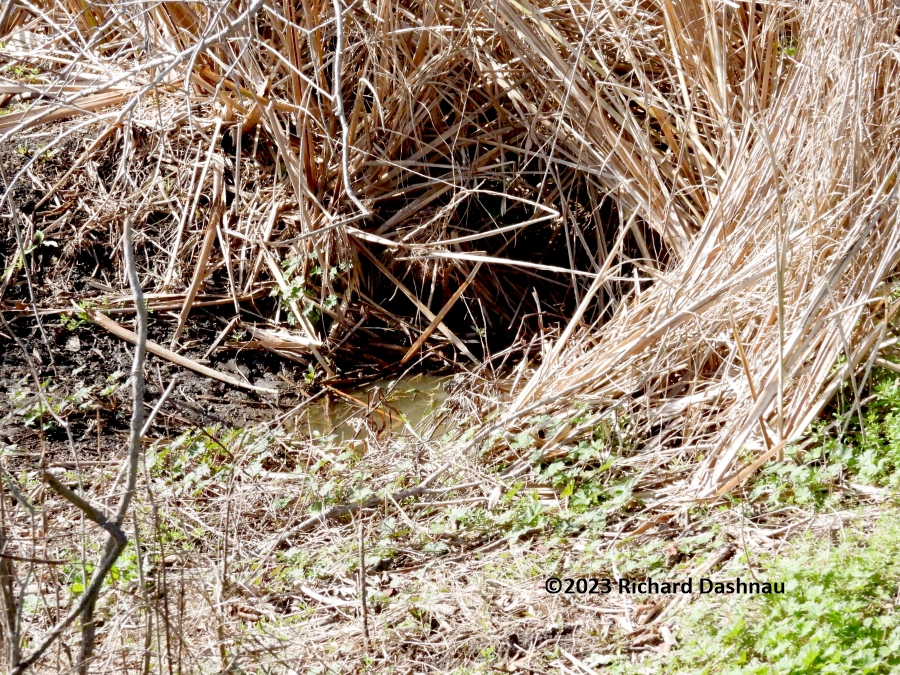
01/22/2023
When
I checked on the den about 8:15am, I found a little bit extra.
The
carcass of some kind of mammal was floating in the water.
Unfortunately, as the
pictures
show, I couldn't avoid having my shadow fall across the den
opening.
While I tried to get better telephoto shots of the carcass
while
adjusting the light
compensation, I saw the carcass move...just a
bump, really. I was pretty sure that the alligator was in the
den, so I
backed away. I had to move on, anyway. For
years I've heard
that an alligator might store a carcass in its den and leave
it to
"ripen". But I've never seen it written anywhere, or observed
it. In
the book
Biology and Evolution of Crocodylians by Grigg and
Kirshner (2015) I found this: " It is known that
crocodylians
prefer fresh,rather than putrid, food, though they
will eat
carrion. There are no data to support the commonly held belief
that
crocs routinely stash a carcass to rot before they eat it."
(page 193)
For whatever
reason, there was a carcass with fur in the den that
morning. Unfortunately, I couldn't stay around to
wait and
see if the alligator would come out and eat. I went
back a few
hours later-about 1:30pm, and the alligator had come out of
the den. I
was happy to get pictures of the alligator and den
together.
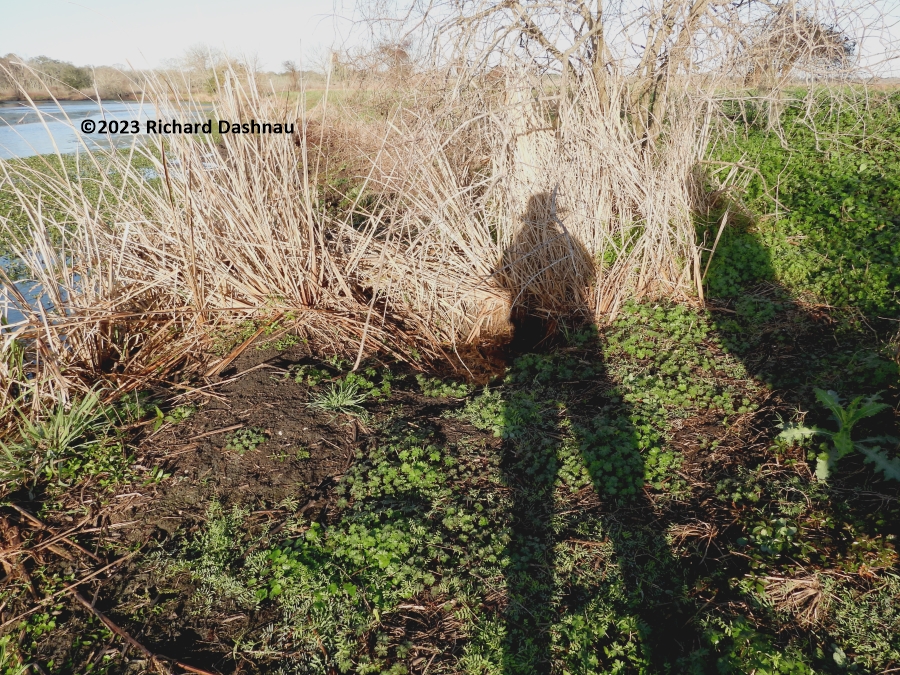
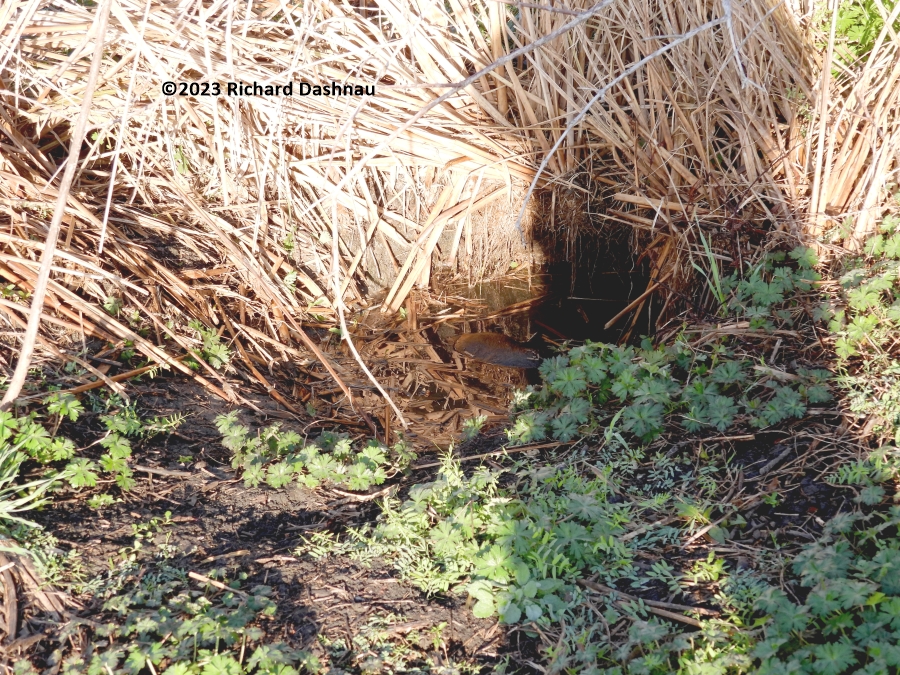
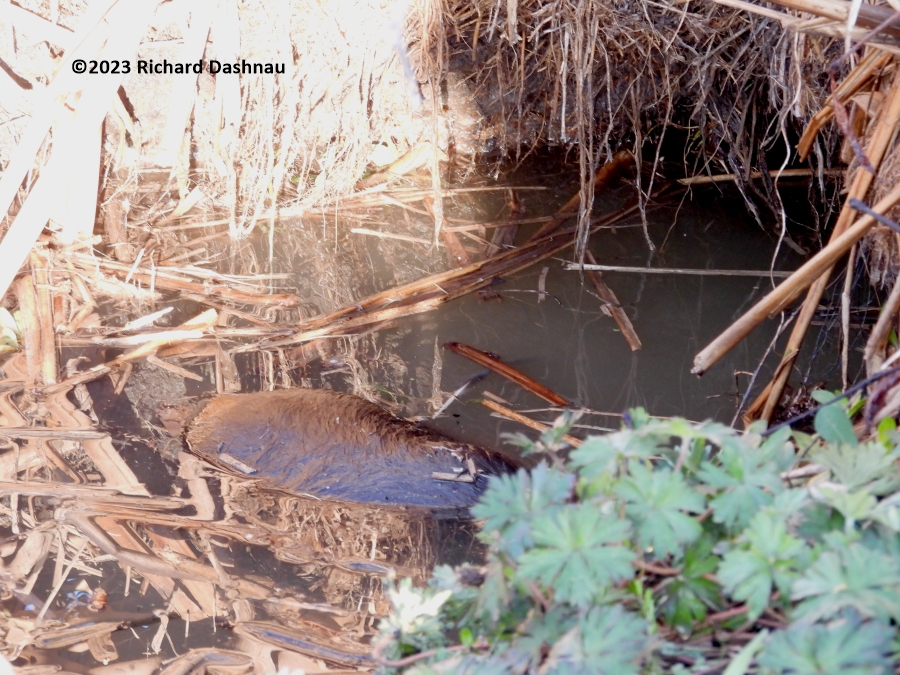
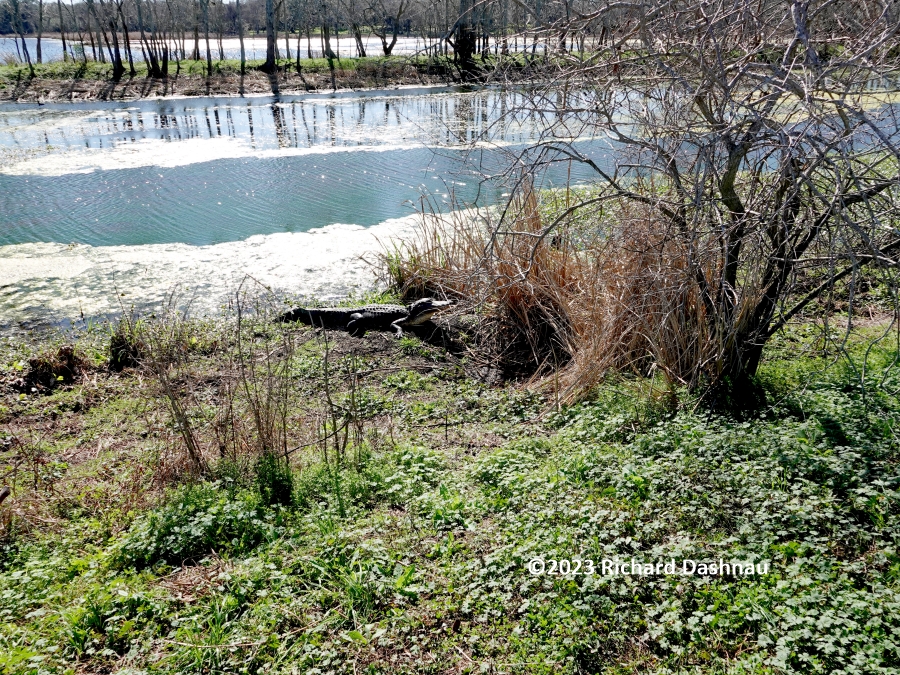
I
moved on after getting a set of pictures. The alligator was
still out
at 4:15pm. There's one picture below--note how the position of
the
shadow has changed. It's
hard to tell from the photos, but the
alligator did seem to be a bit bloated. So, it could have
eaten the
carcass I'd seen that morning.
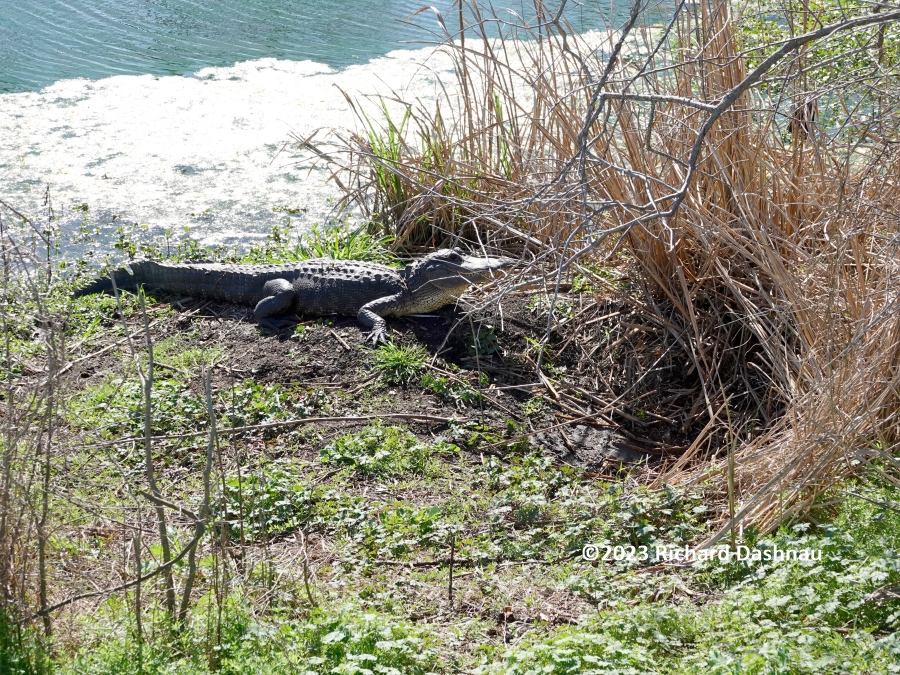
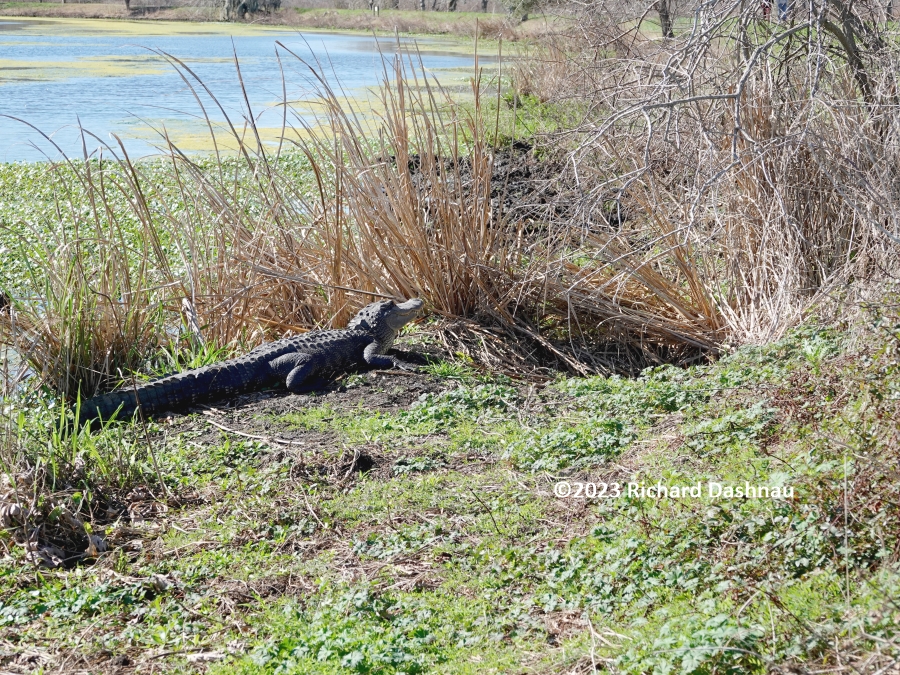
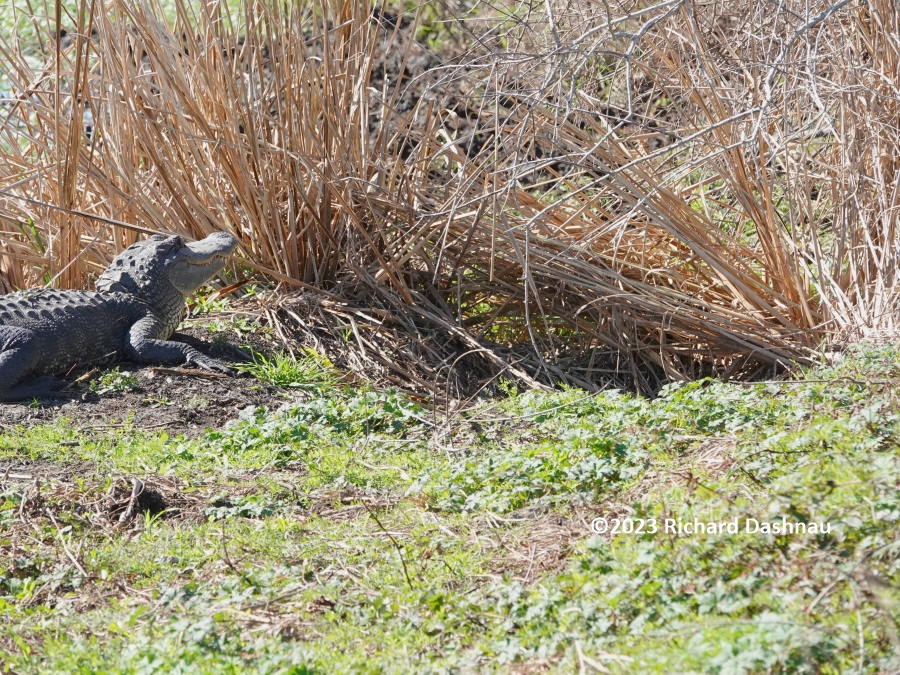
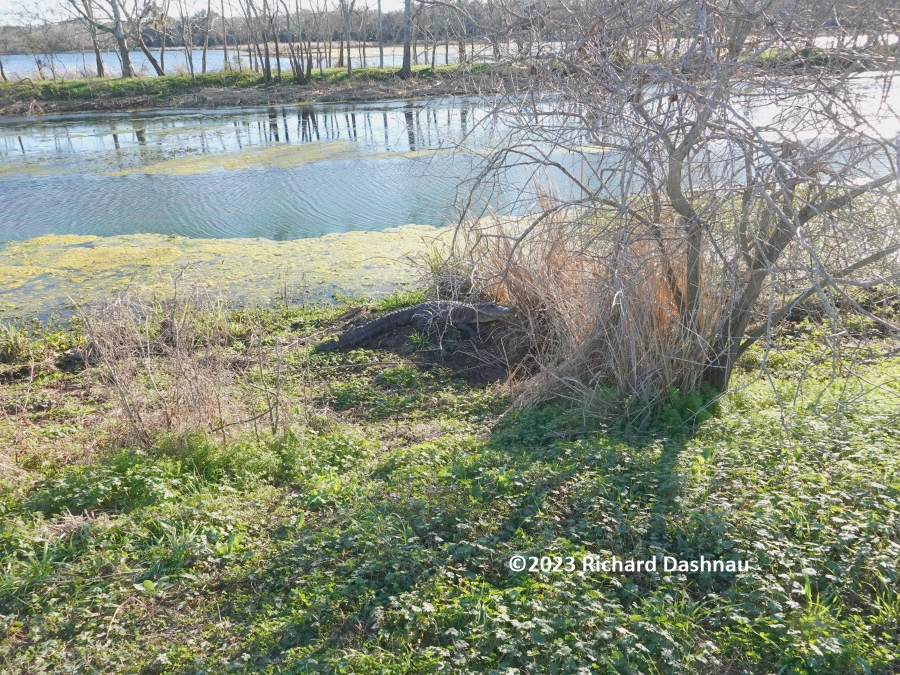
02/12/2023
When
I checked on the den about 9:15am, I got a quick look at the
tip of an
alligator's snout, but it submerged. Betrayed by my shadow,
again!
But when
I returned at about 1:30, the alligator was out on
its mound. Since it had been out for a while, I thought that
it might
want to go back into the water, and hopefully,
back into the den.
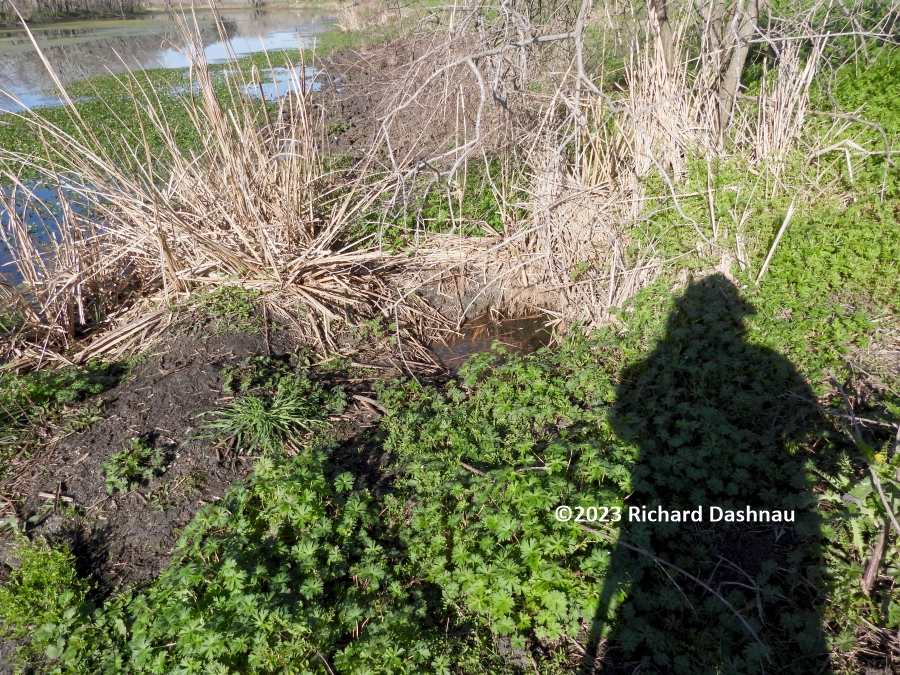
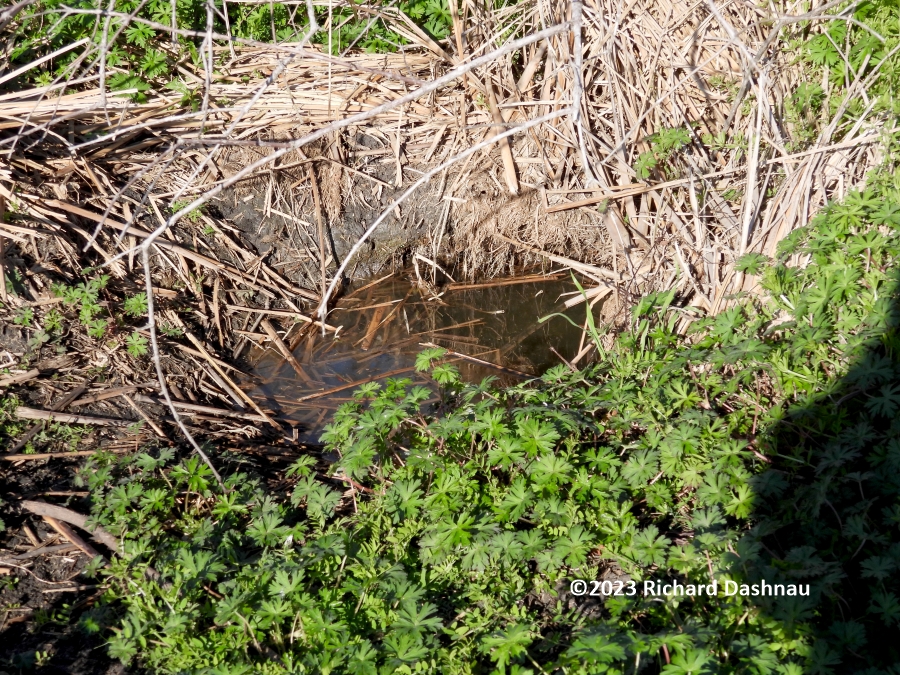
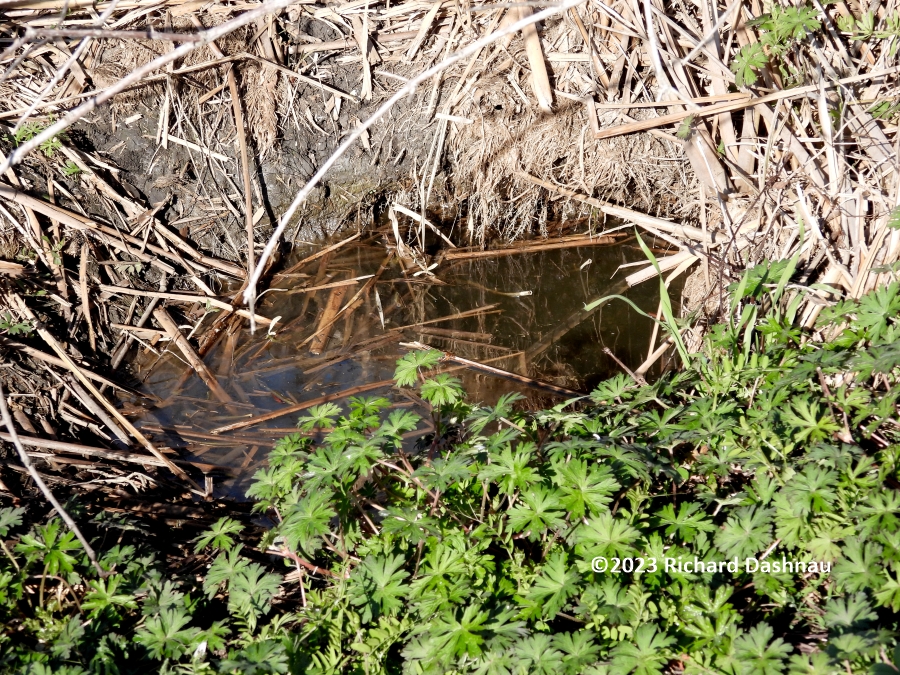
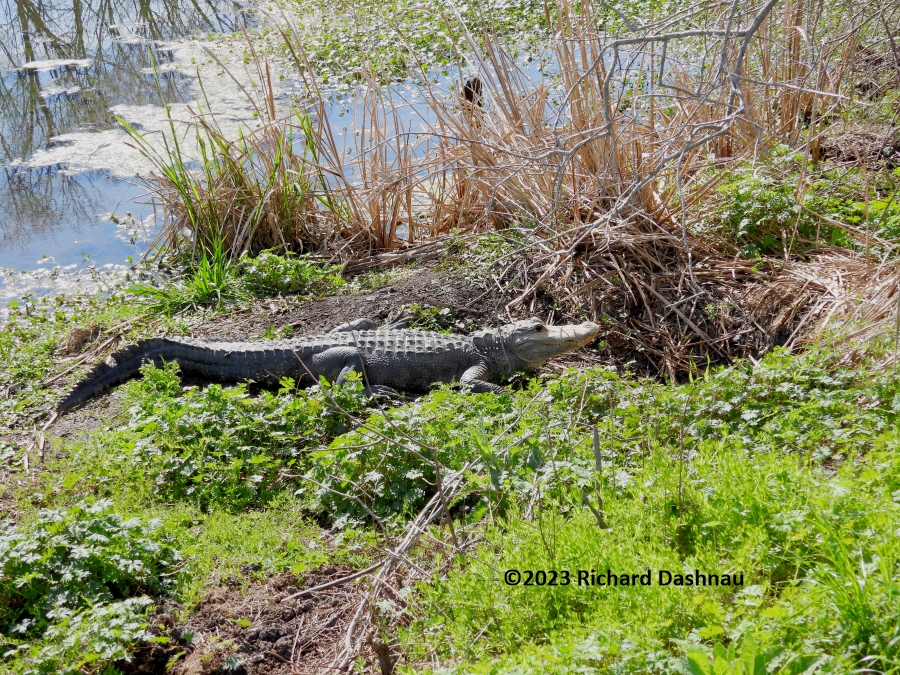
About
30 minutes later, the alligator started to open its mouth,
doing a
"thermal gape"--showing that it was overheating. I was
rewarded for my patience a few
minutes later, when the alligator crawled
into the den! I'd finally captured an alligator using
a den on film!
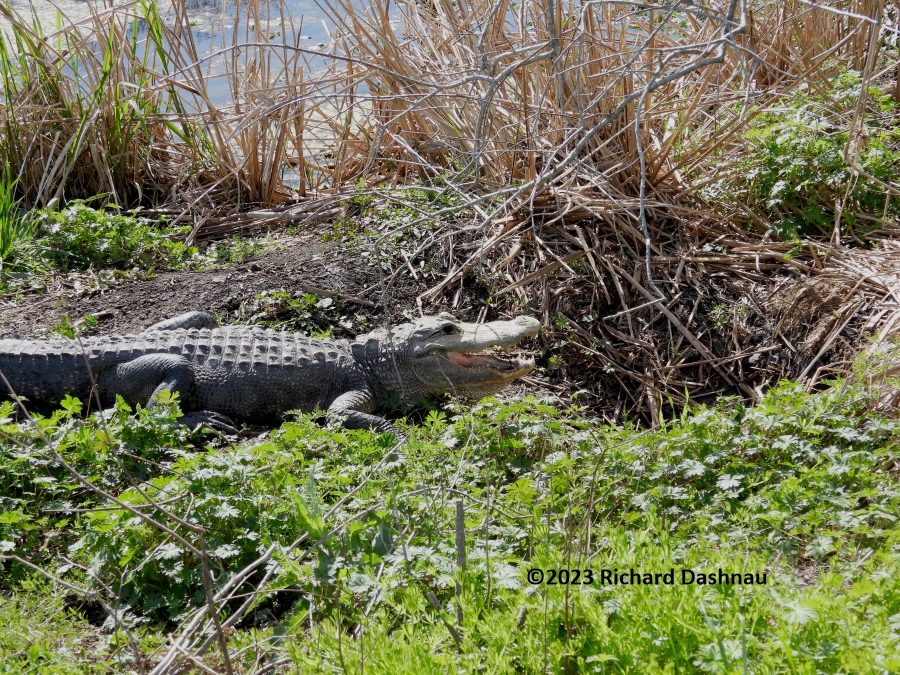
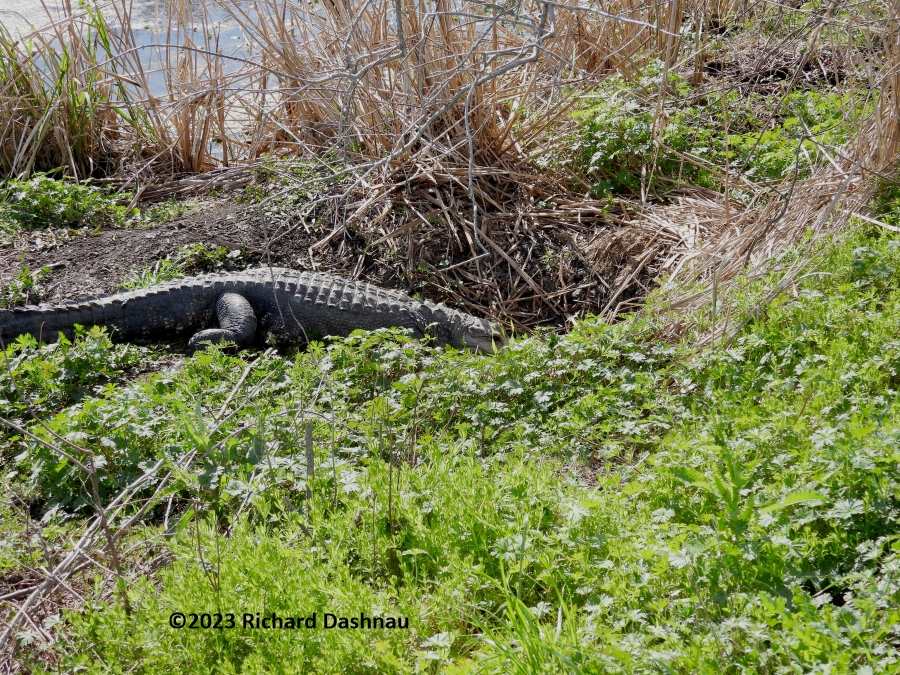
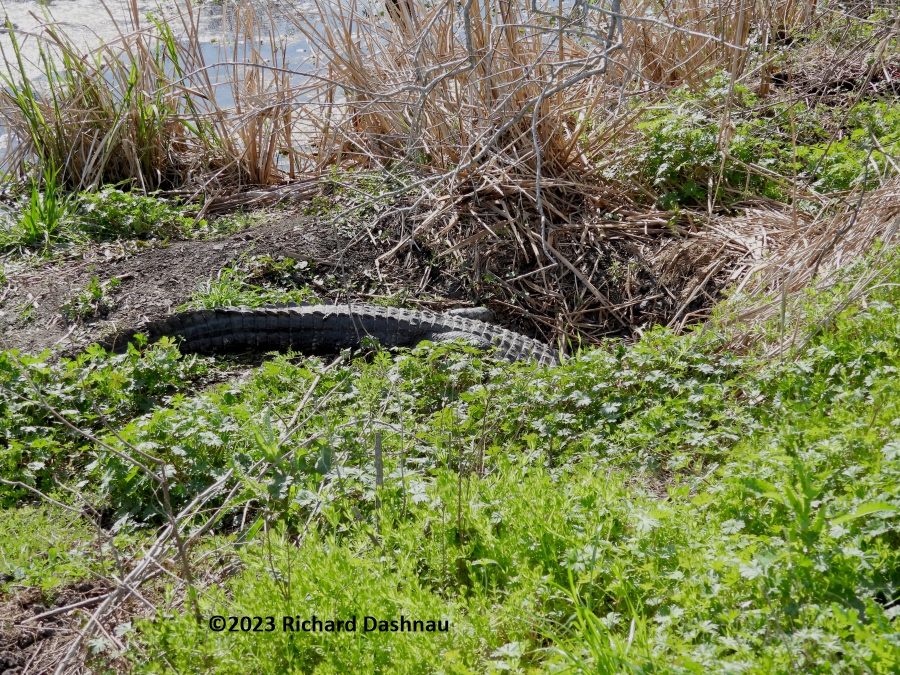
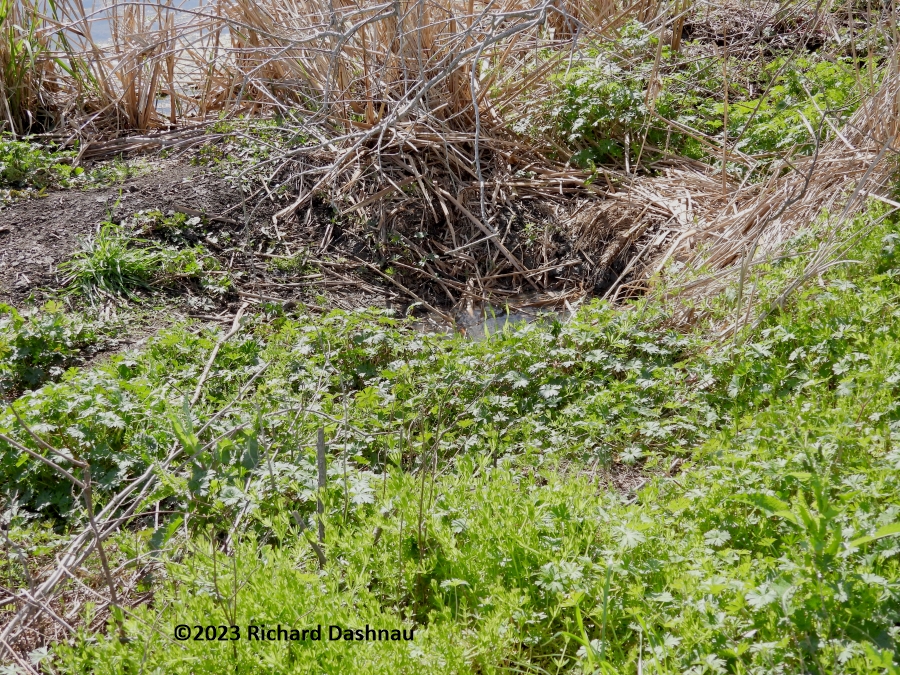
02/19/2023
At
9:00, I checked the den, and again saw the tip of a gator's
snout under
the water. I took a few bad photos before the snout withdrew
further
into the
den. This time, I decided to wait until the alligator
appeared. About 9:40, the alligator's snout appeared at the
edge of the
hole, and then it just stayed there.
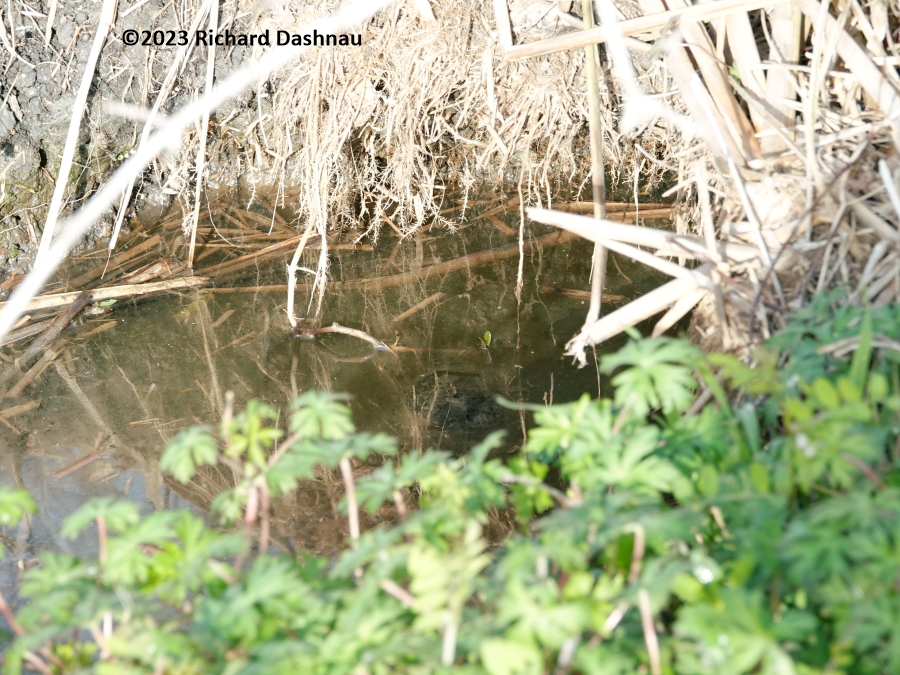
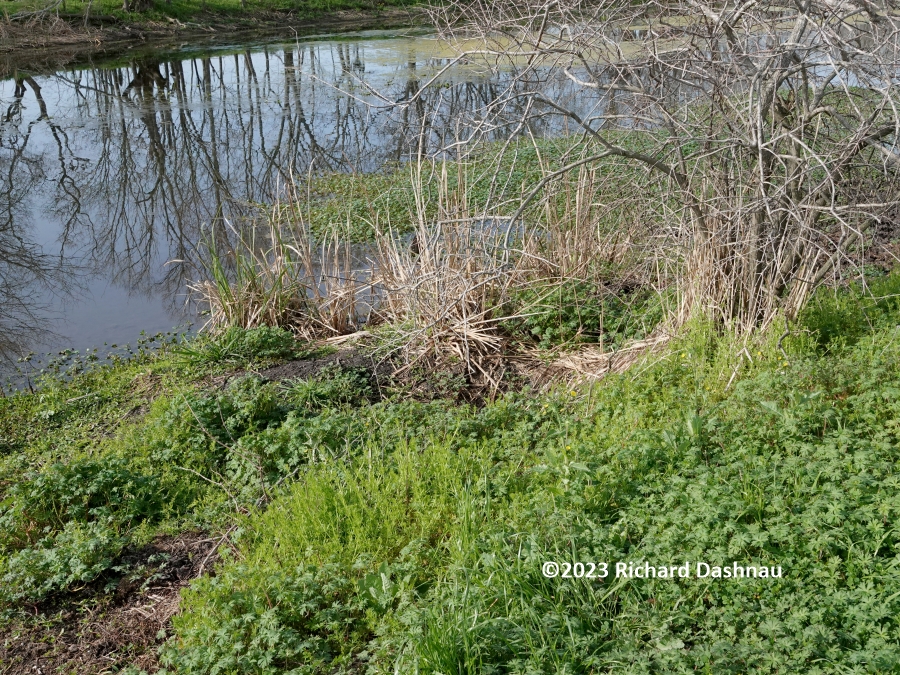
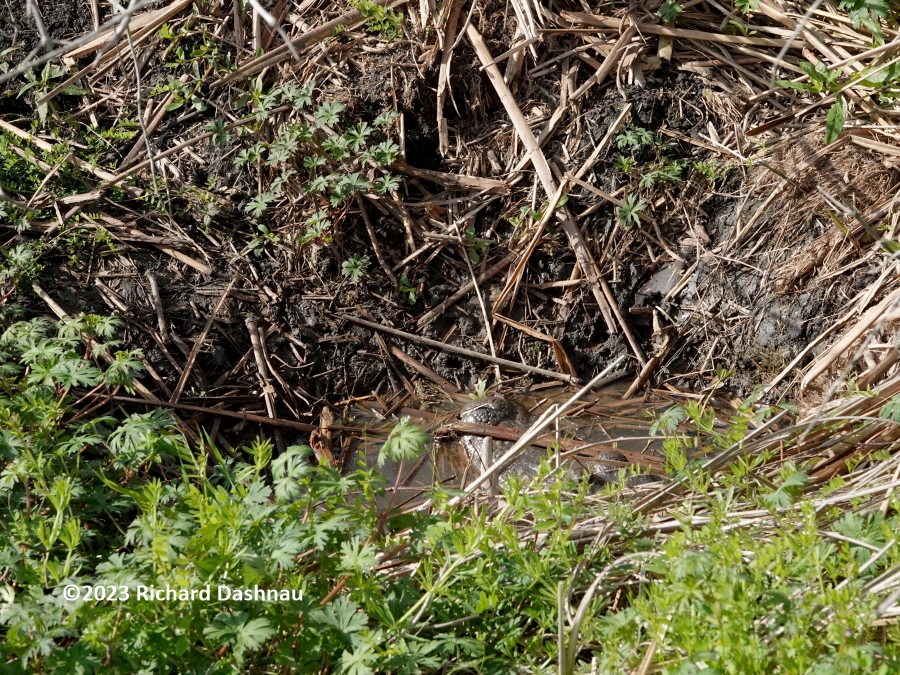
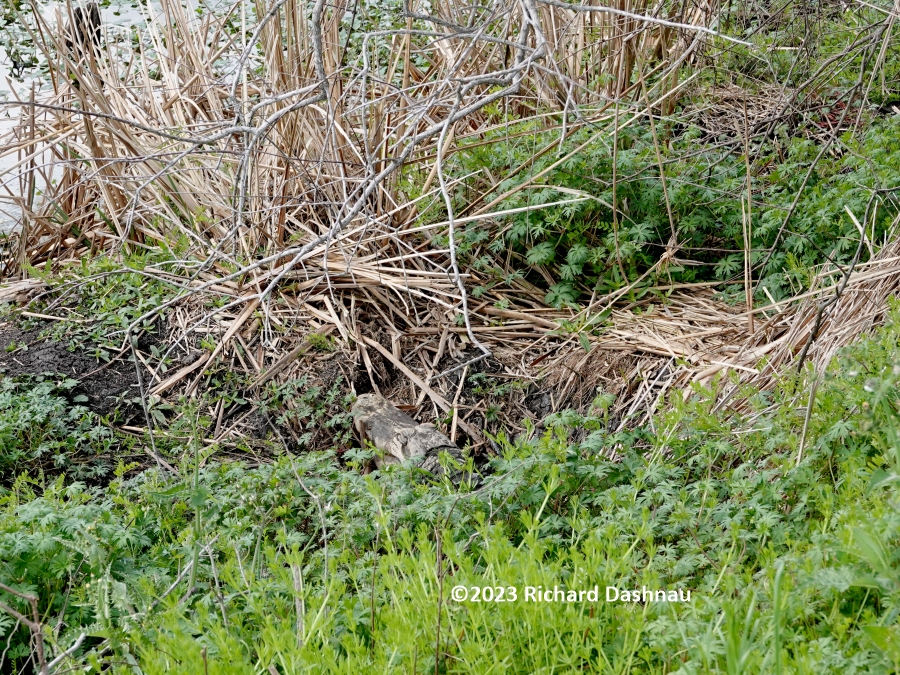
Around
11:00,
the entire head, and front legs emerged from the hole.
About 10
minutes later, the alligator crawled out of the den! It
crawled out,
curled around and layed
down.
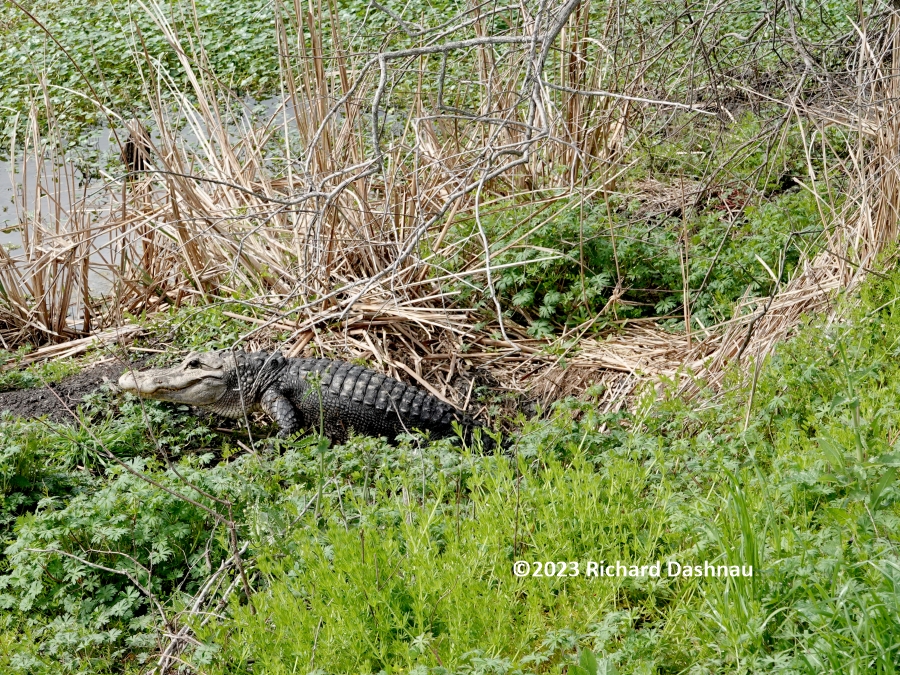
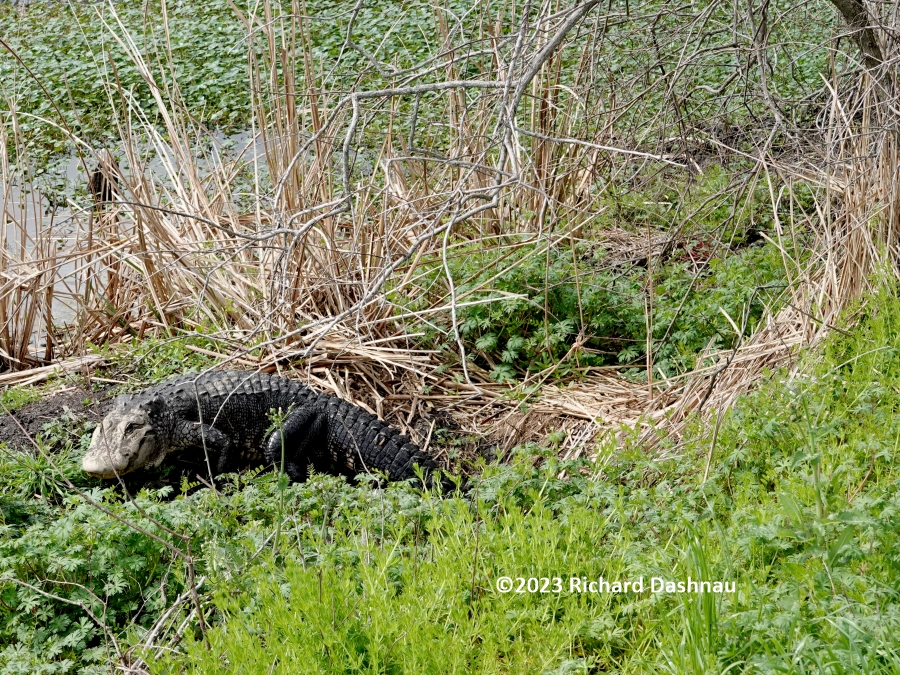
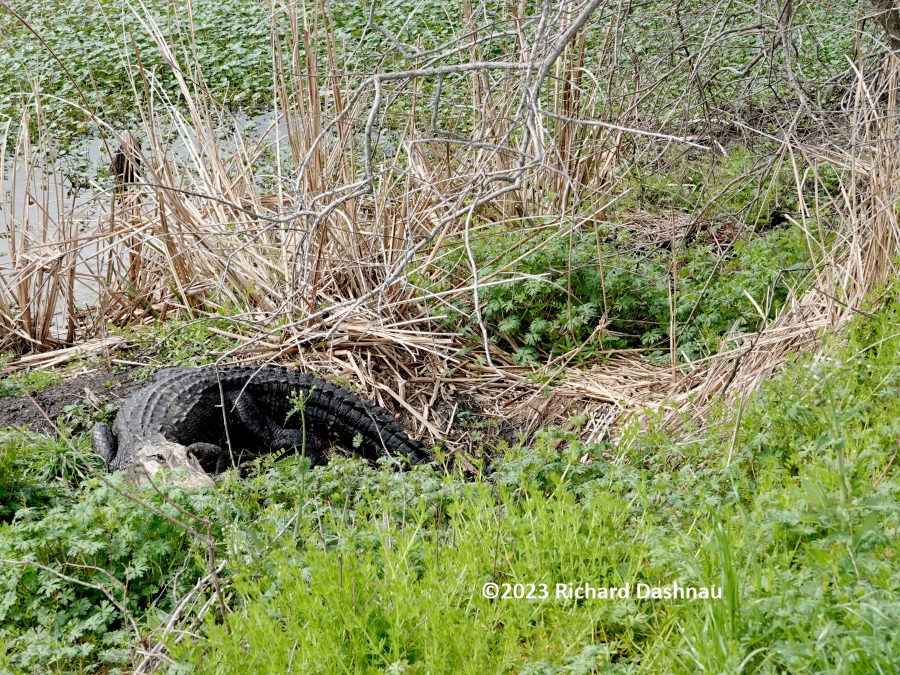
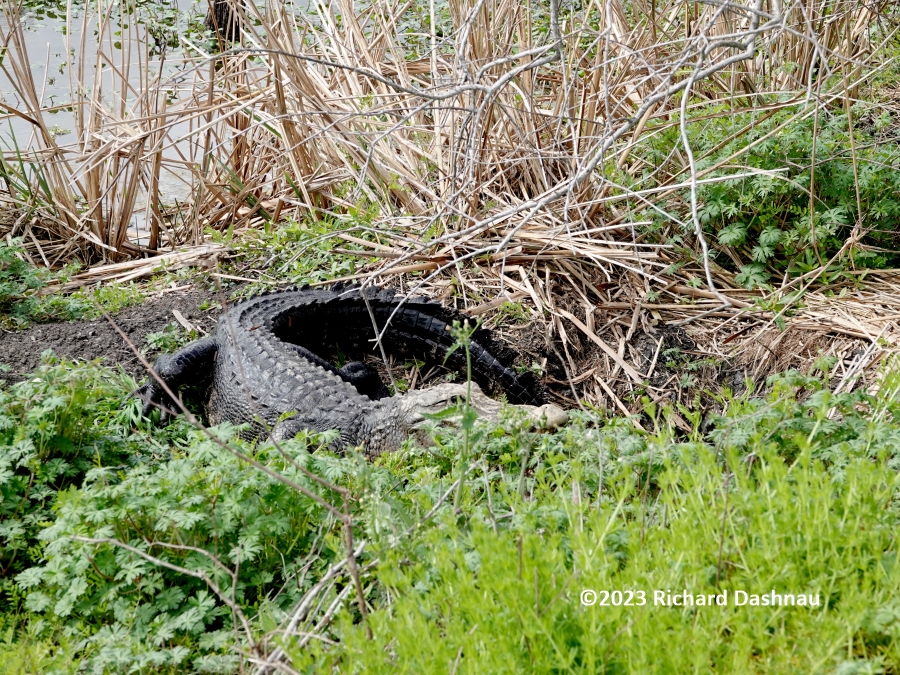
But,
apparently it didn't like the crowd of humans that were
watching, so it
crawled back into the den just a few minutes later.
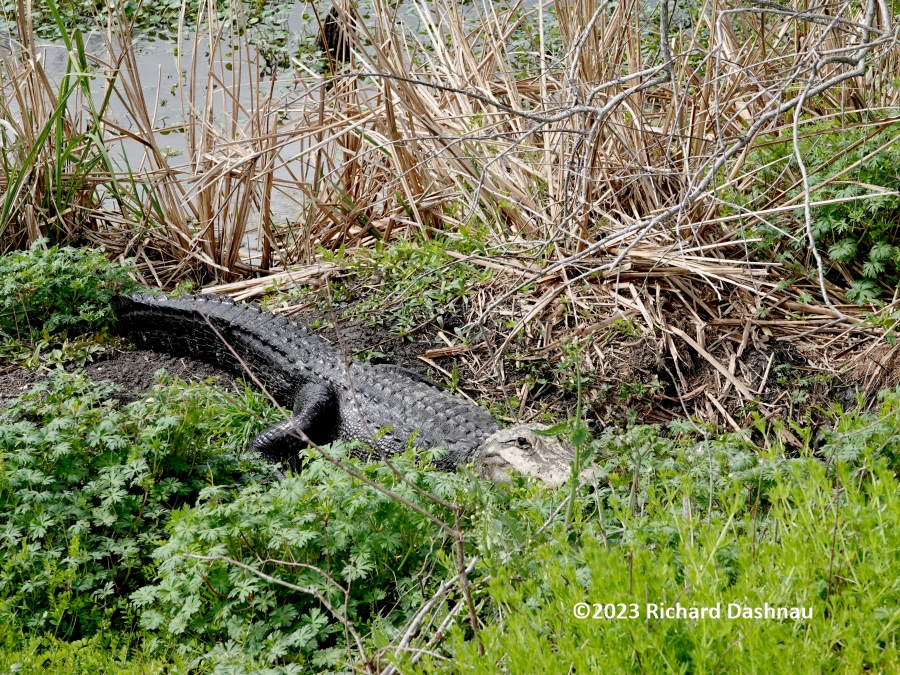
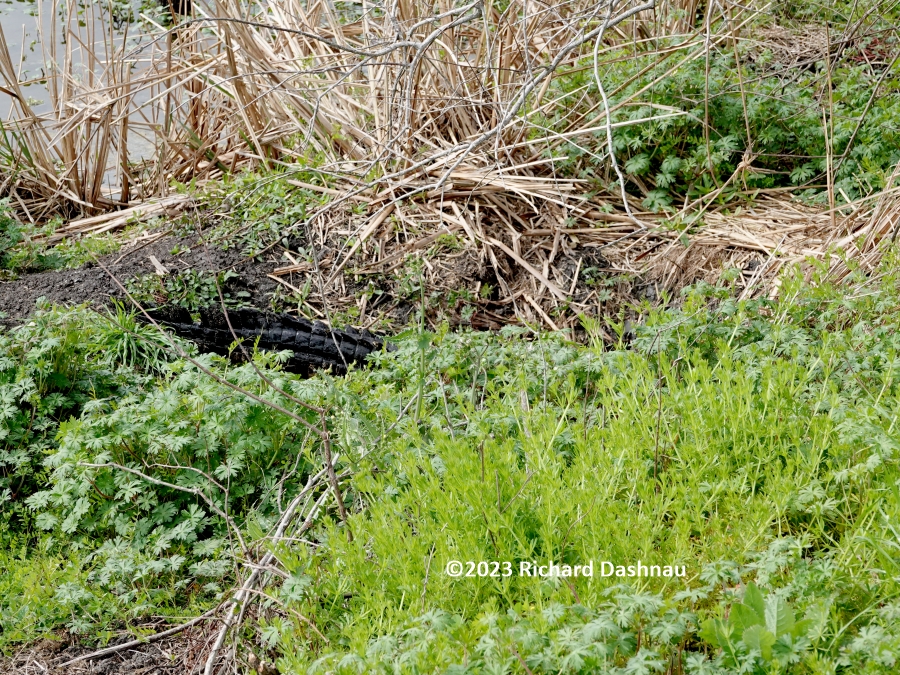
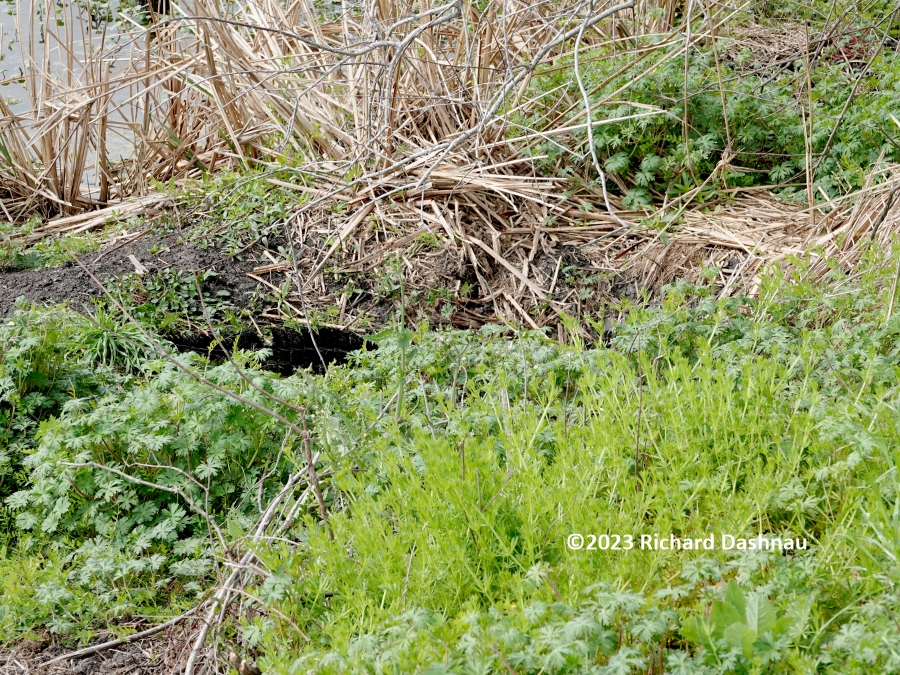
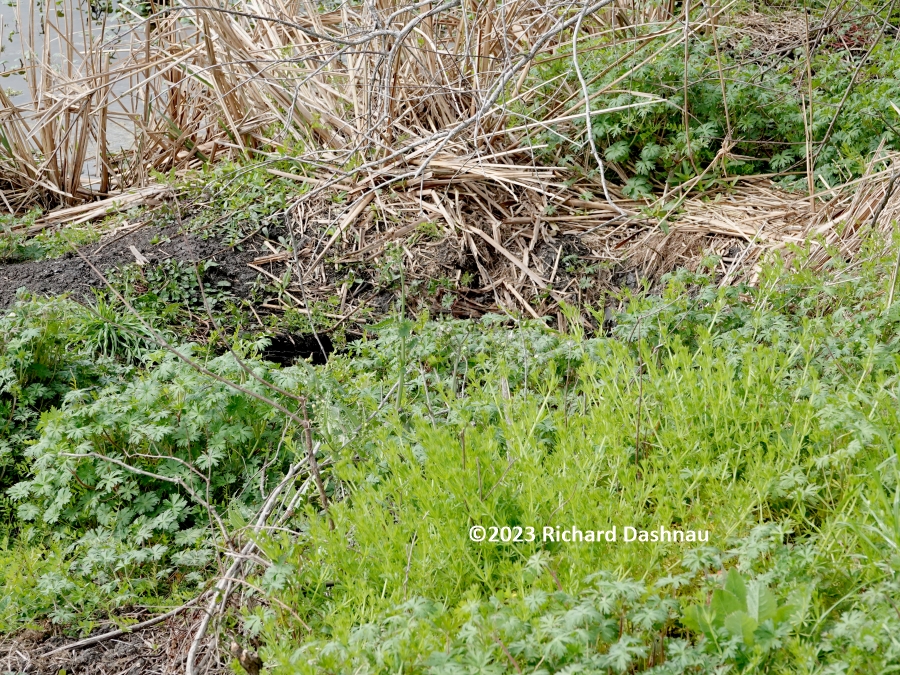
03/12/2023
Plants
around the den have begun growing, and blocking the den from
view. I
can't see any definite signs that the alligator has pushed
through the
plants,
but I really couldn't see much at all. It might still be in
there.
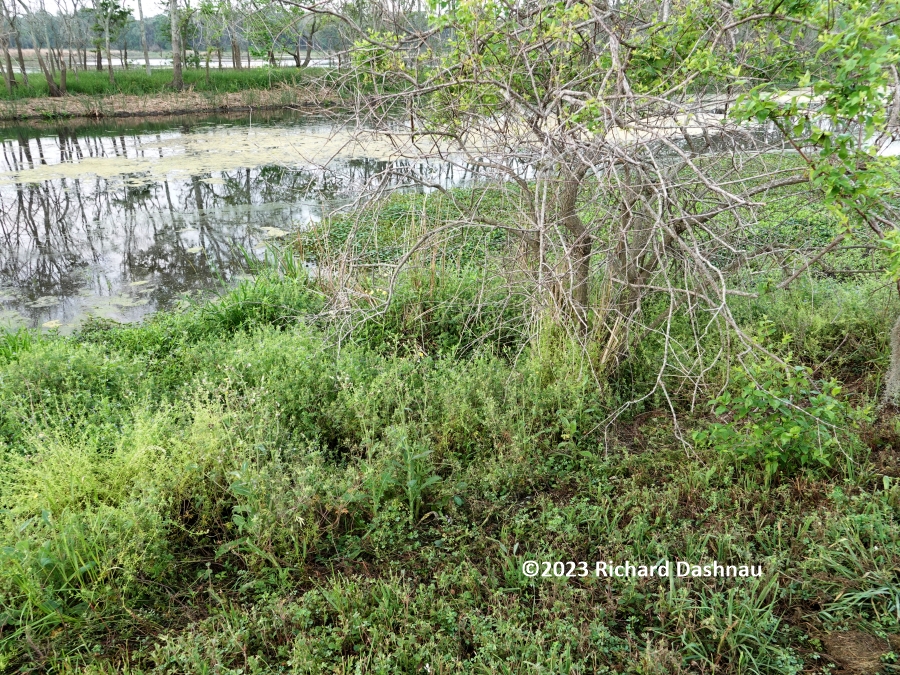
03/19/2023
A cold front had passed through recently. This
morning, the thermometer in my car showed 47°F.
I didn't bother trying to record the air temperature
on
the trail because I was trying a new piece of equipment that I
thought
would give me related data. I can say that It felt
REALLY cold
out there. I took the
images below with my phone, and with the new
device. I was trying out a FLIR one thermal camera which
connects
to the USB-C port on my phone. It has its own
optical camera, along with the thermal imager.
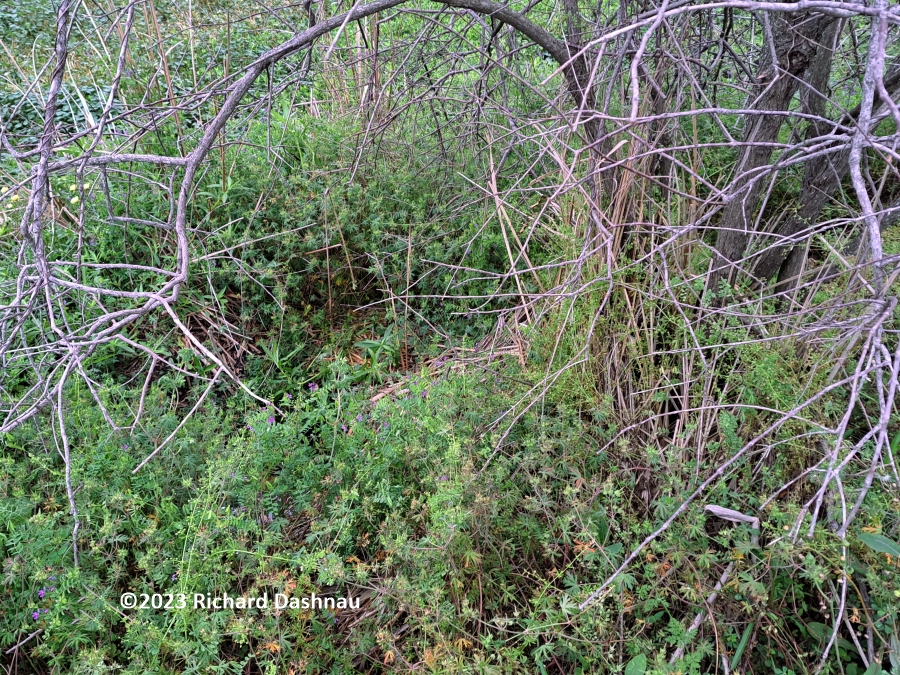
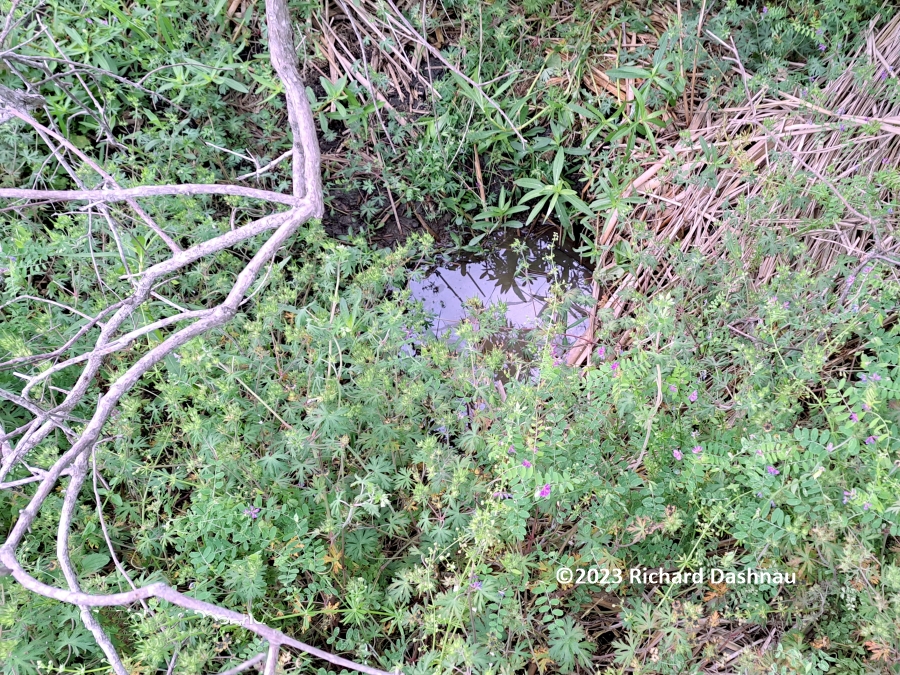
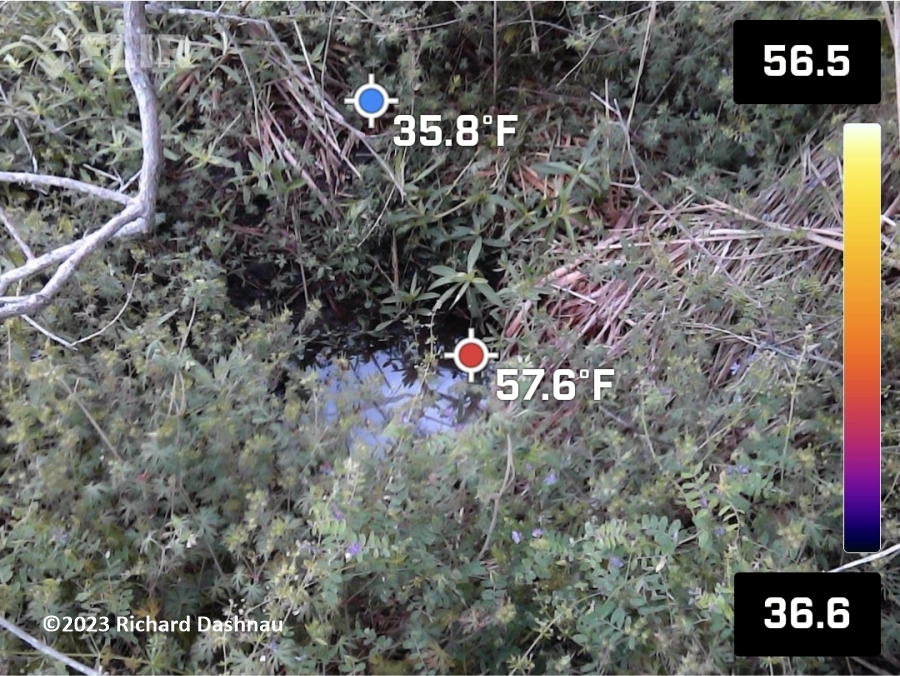
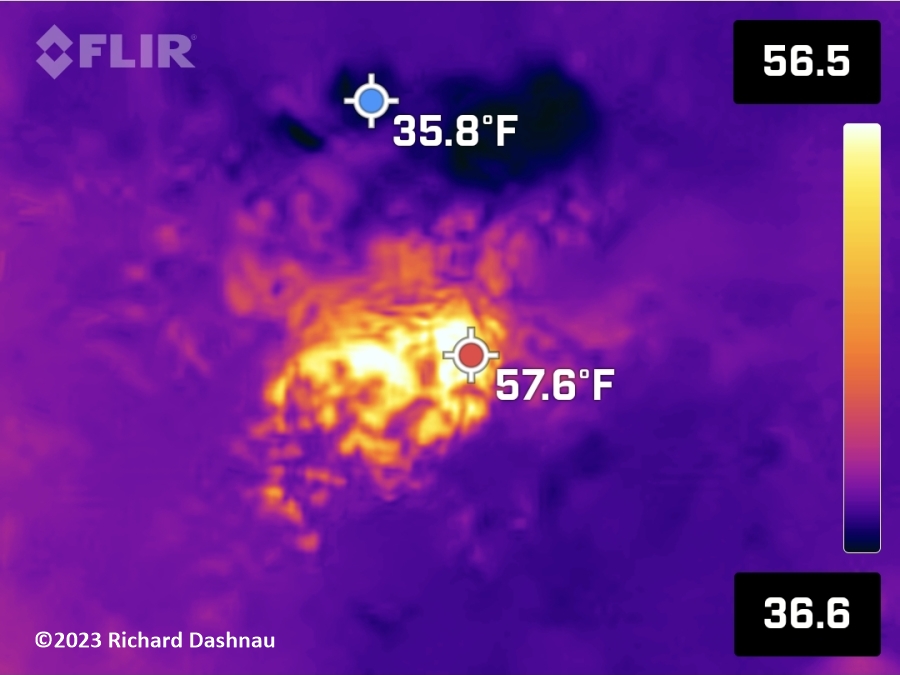
I
decided to try to use the phone that is part of my camera, and
after
that the FLIR stopped working. I probably just needed to
restart the
camera, but that morning
too much was going on.(For
one
thing, while I was holding my phone in one hand, and the FLIR
in
the other, a Bald Eagle flew right over me.) I was still
learning
about the FLIR one, so I didn't use it more that day. BUT, I
got these
thermal images, and they are really interesting. So, the
imager works off of surface temperatures,
so air temperature will not register. In the images looking
down at the den opening the device snagged a 35.8°F
and a 57.6°F high
and low. The imager is always
sampling, so these points can fluctuate as I move the camera
around. The 35.8°F
isn't really a surprise-I said it was cold. But look at the
reading off the water in the
den!
It was 21.8 degrees warmer in the den than the lowest
measured
spot! The den opening is obviously warmer than the
surrounding
area. It's one thing to
read about how an alligator's
den is an environmental control chamber, but it's amazing to
actually
see it demonstrated in the field! There are many reasons
for
this
temperature difference. The sun shines on the bank for
most of
the day. Water and dirt can work as insulators, and also
as heat
storage. It hadn't been cold
for
weeks, but only for a day or two. What else can be warmed by
the sun?
The alligator! If this alligator was able to spend
time in
direct sunlight, then its skin-
and the osteoderms-would have been
warmed by the infrared. The alligator's blood would circulate
past and
through the warmed structures, carrying warmed
blood into its
body. Given enough time, the alligator's internal temperature
could be
warmer than the surrounding air...or the surrounding water. A
solar-heated alligator
making multiple trips to an enclosed water
vessel (which the den was then) could warm the water in the
den, and
give the effect I saw in the thermal image. This is
just
a guess. I haven't read anything about anything like this in
relation
to alligators. But, I have read about a species of snake that
basks to
raise its body temperature,
then returns to its burrow to warm its eggs. Females of this
species temporarily turn
black during the reproductive cycle for more
efficient heat absorption. It's
described
in this study: "Reproductive biology and maternal care of
neonates in
southern African python (Python natalensis)", G. J. Alexander,
2018. So heat being
transferred from a reptile to its environment-instead of the
reverse-isn't such a strange idea.
I'd
hoped to take further thermal shots of the various lakes that
day-because of the cold air-but no luck. Maybe next
time. By
the way, I saw slight movement in the water
down
there, so I think the gator was home. The two images
below
demonstrate the "overlay" ability of the camera. With so many
subjects
(leaves, branches, etc.) in the
vision field the composite image is
a bit too cluttered. As with any device, more experience will
give
better results. Still....not a bad try.
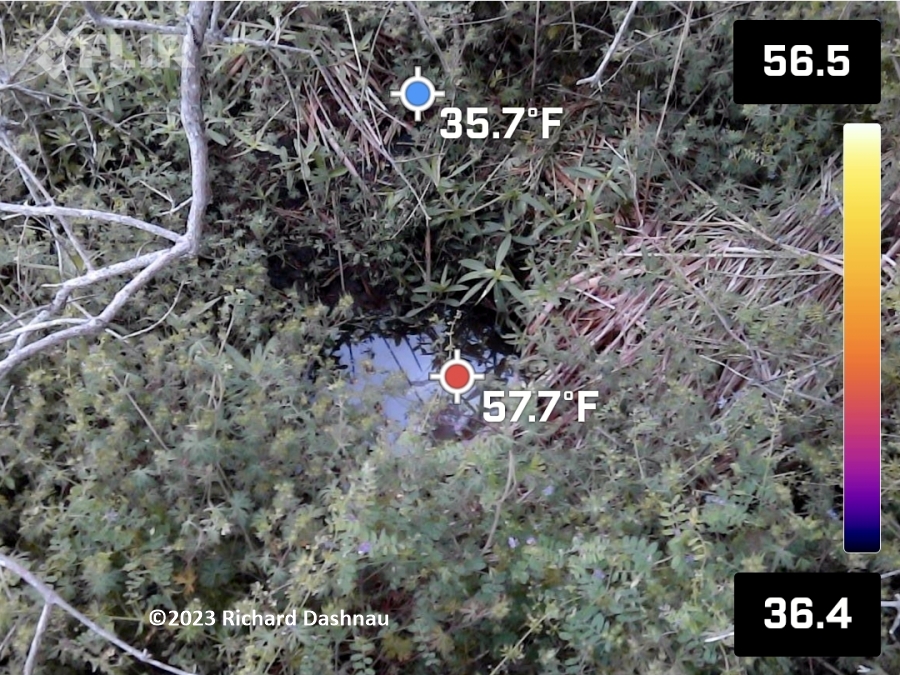
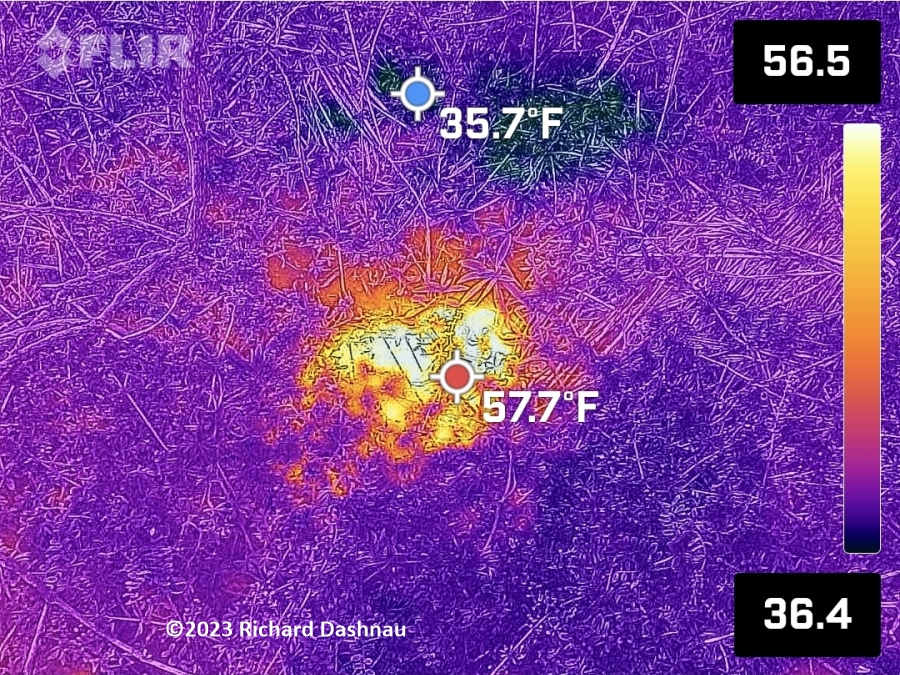
Update
07/14/2023 Using the
FLIR software, I can add test points, clarify images, and
create reports. These images show more information. Click
each one to see it larger. pic 1 pic 2 pic 3
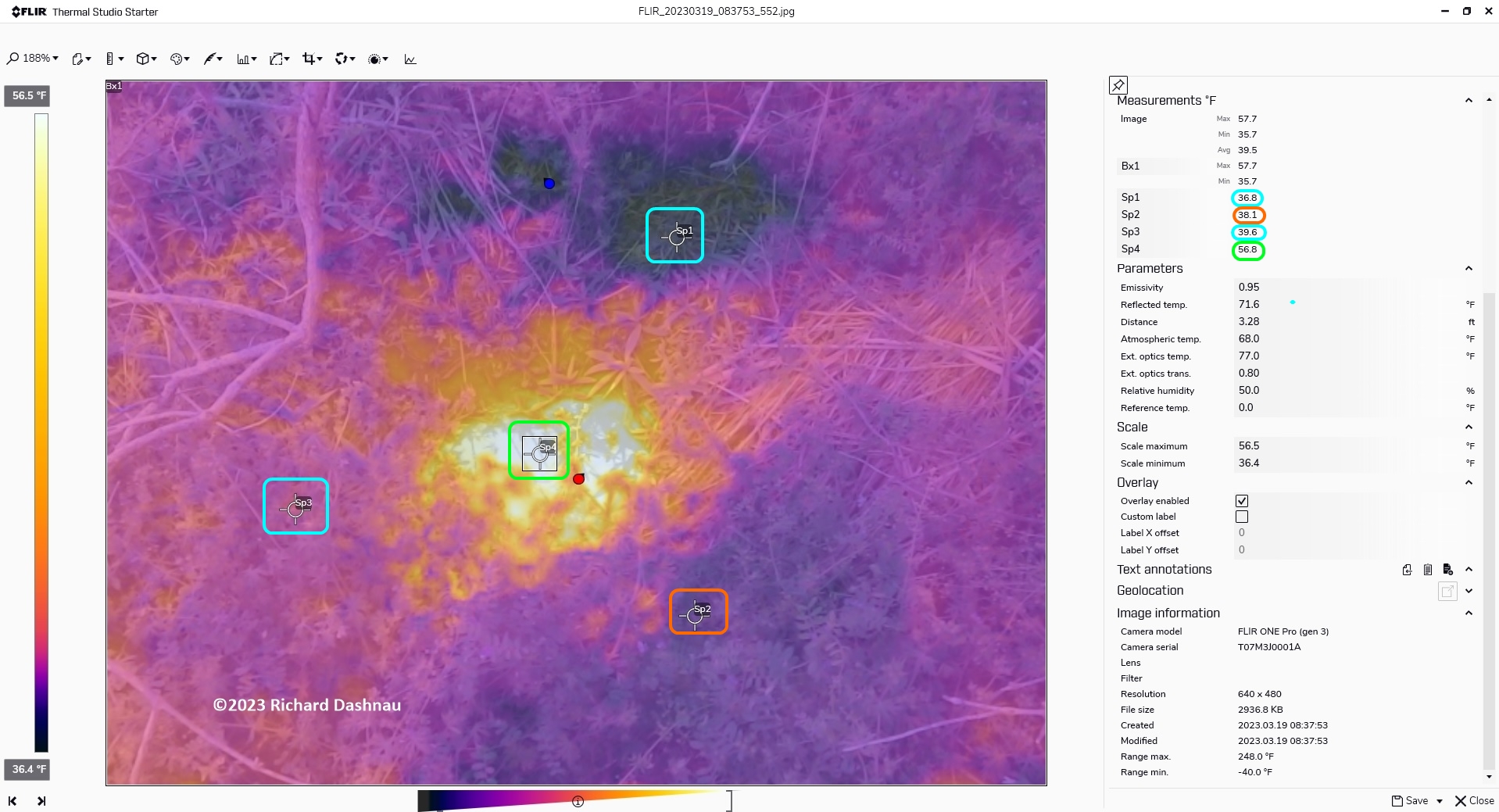
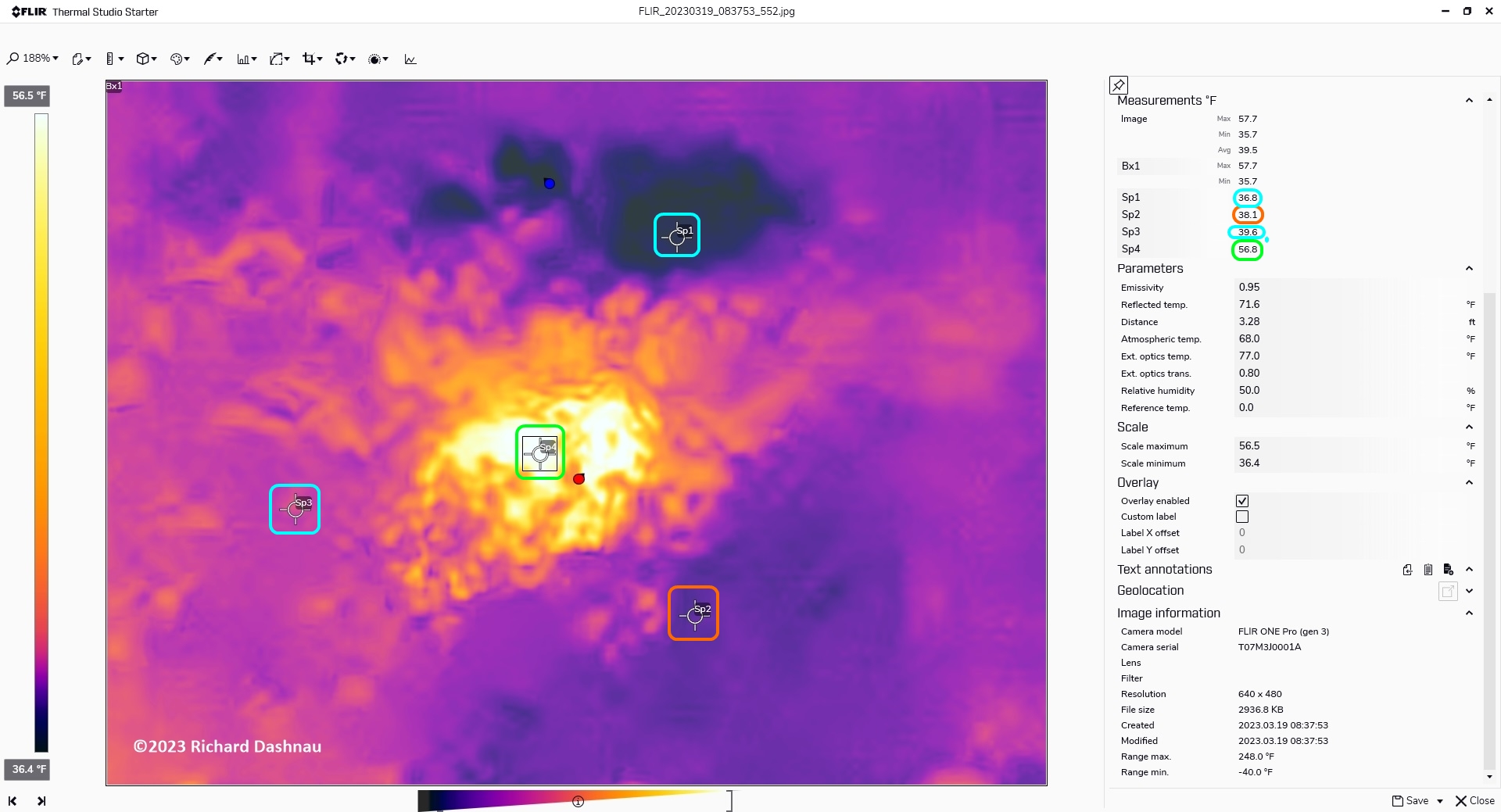
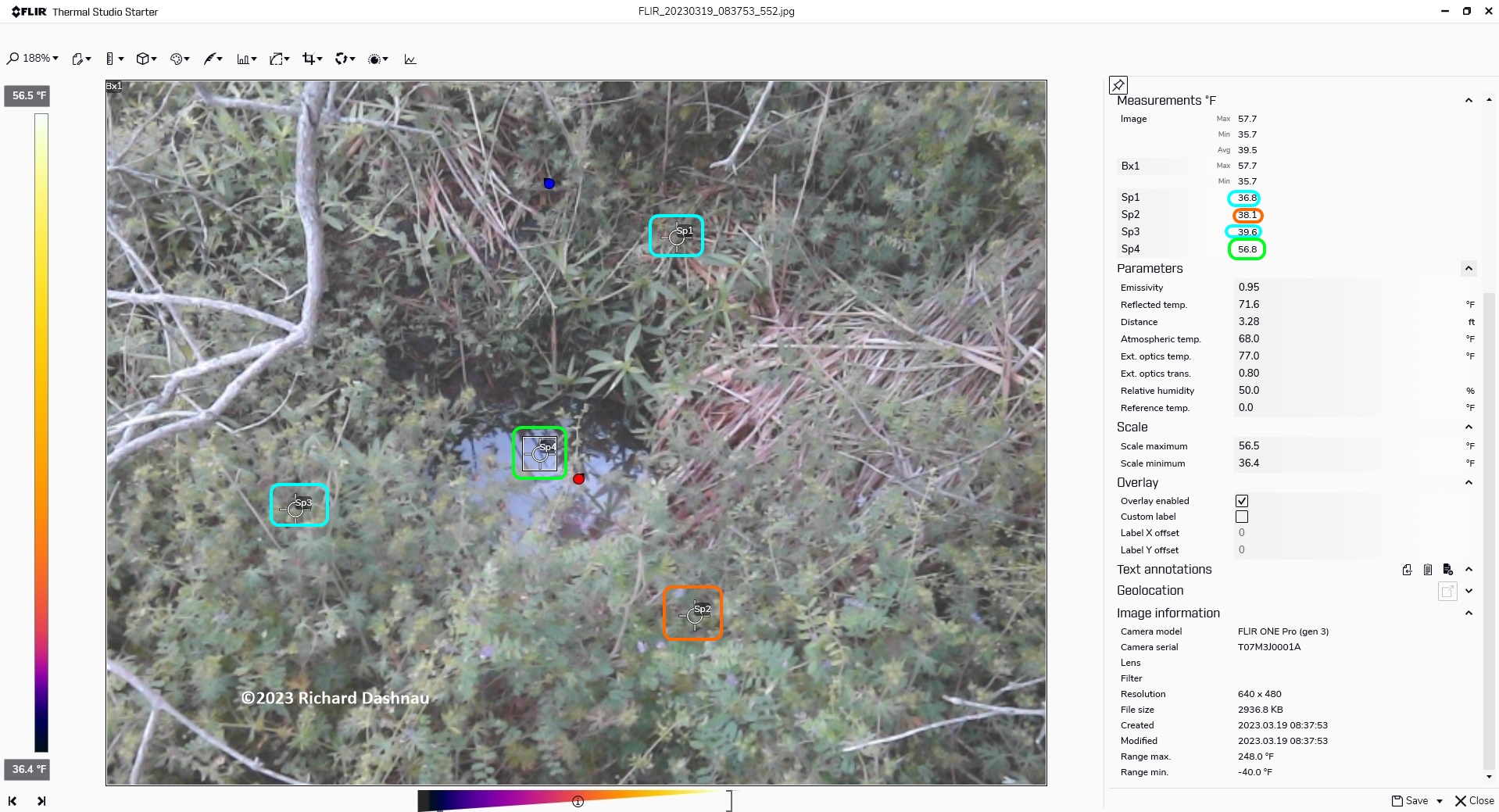
Go
back to my main alligator page, Alligators
Go
back to my home page, Welcome
to rickubis.com
Go
back to the RICKUBISCAM
page.
Go
back to the See
the
World
page.


























































































